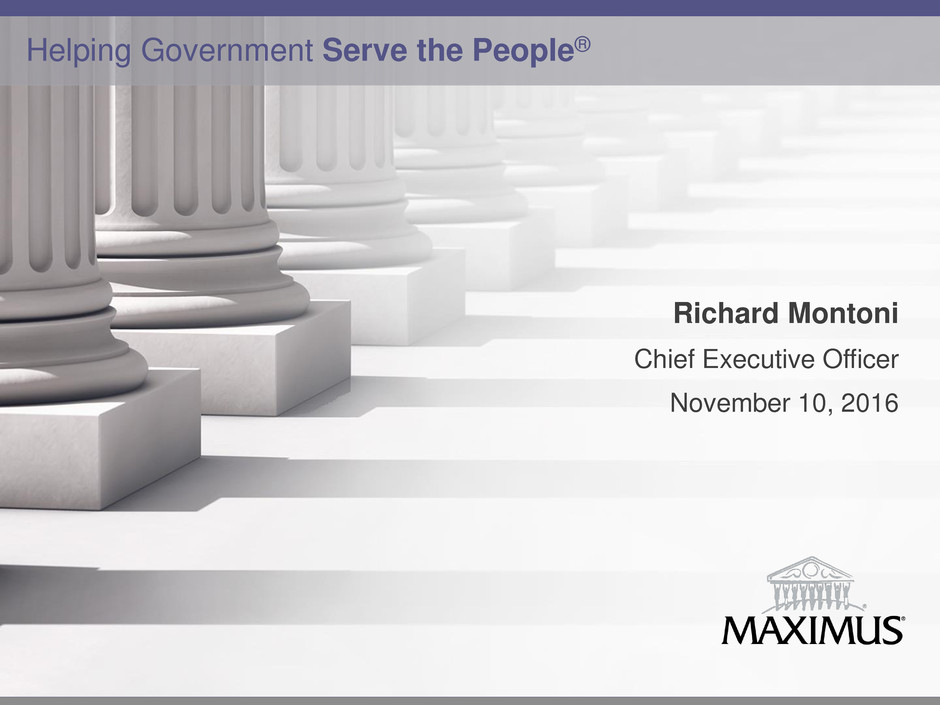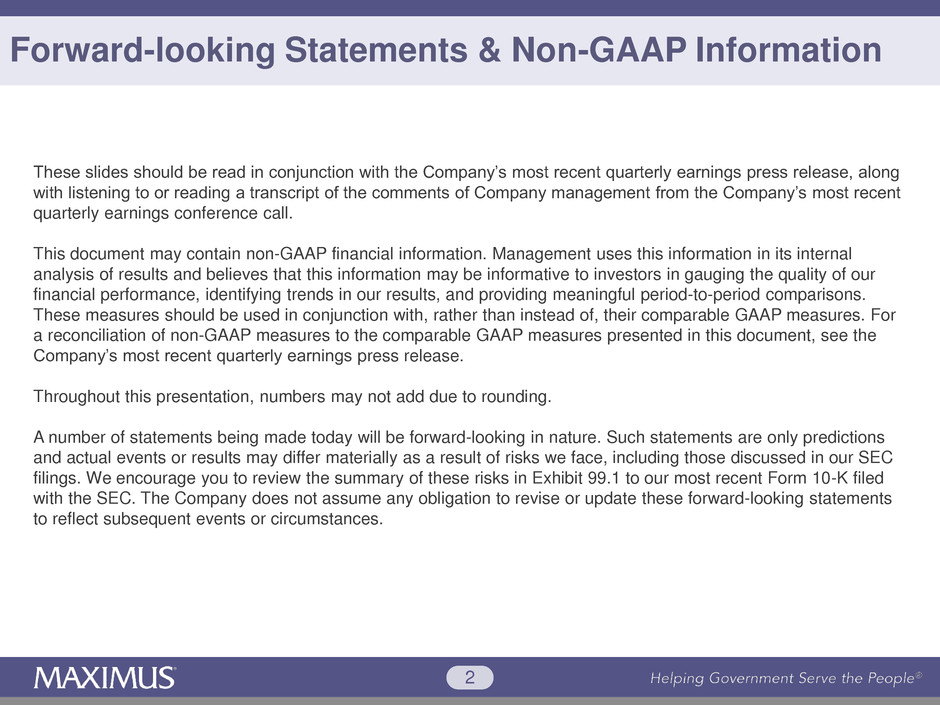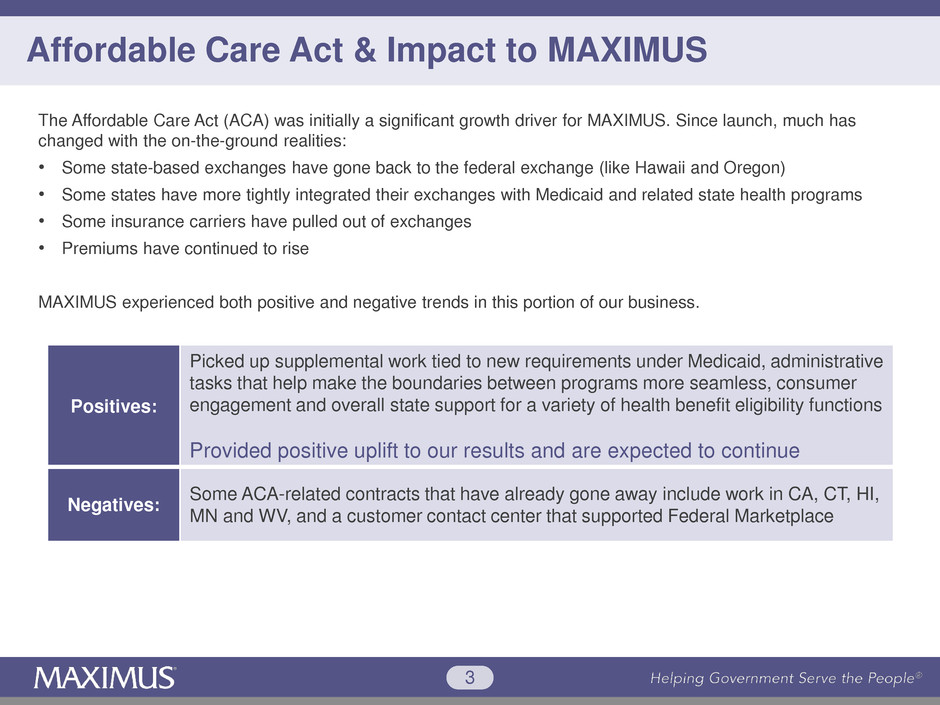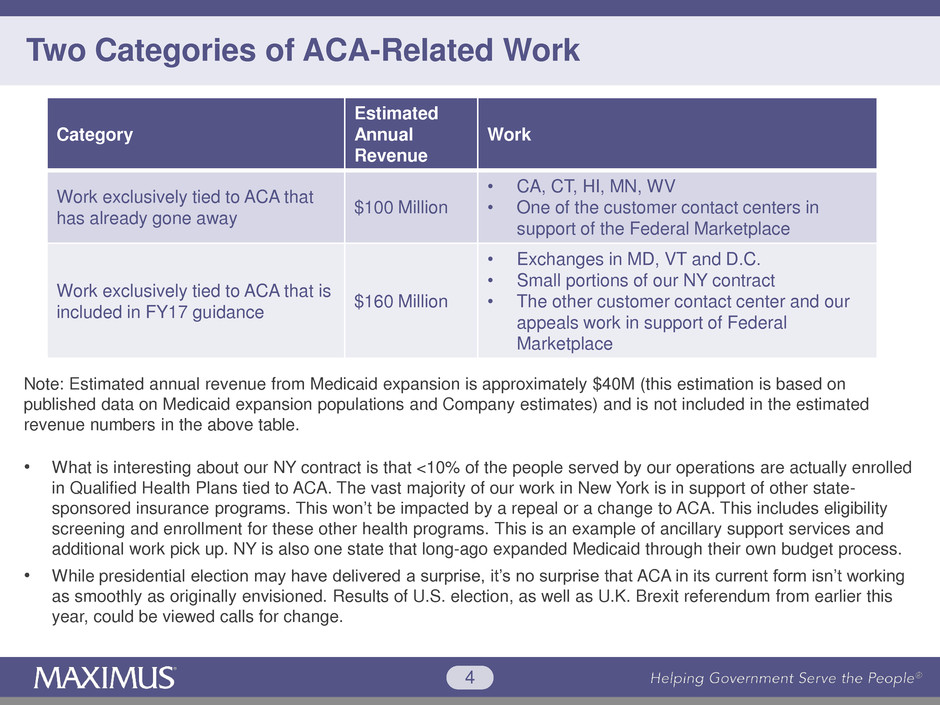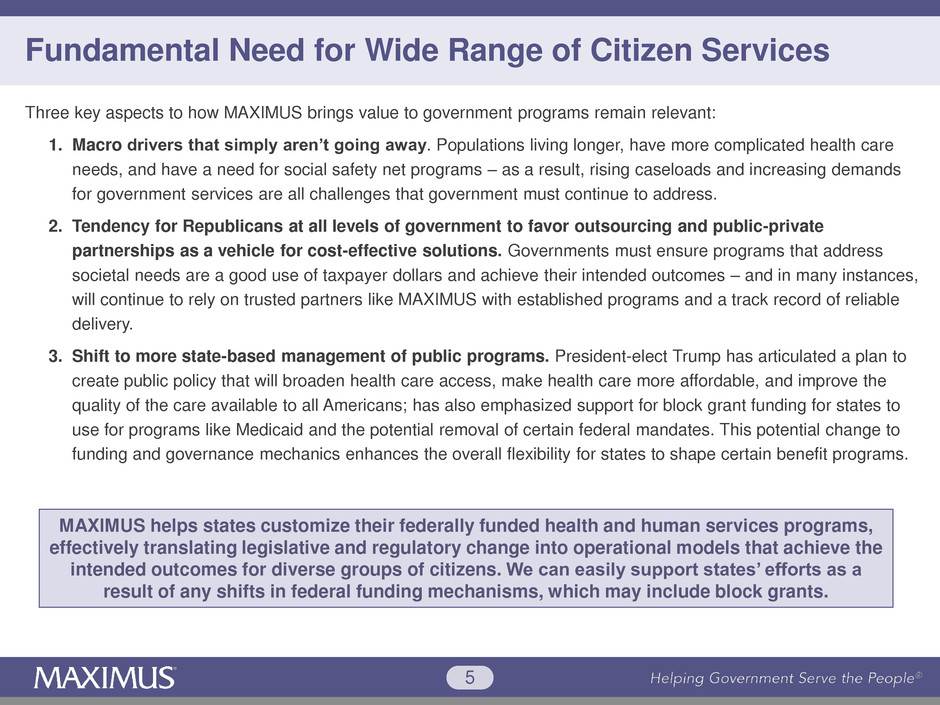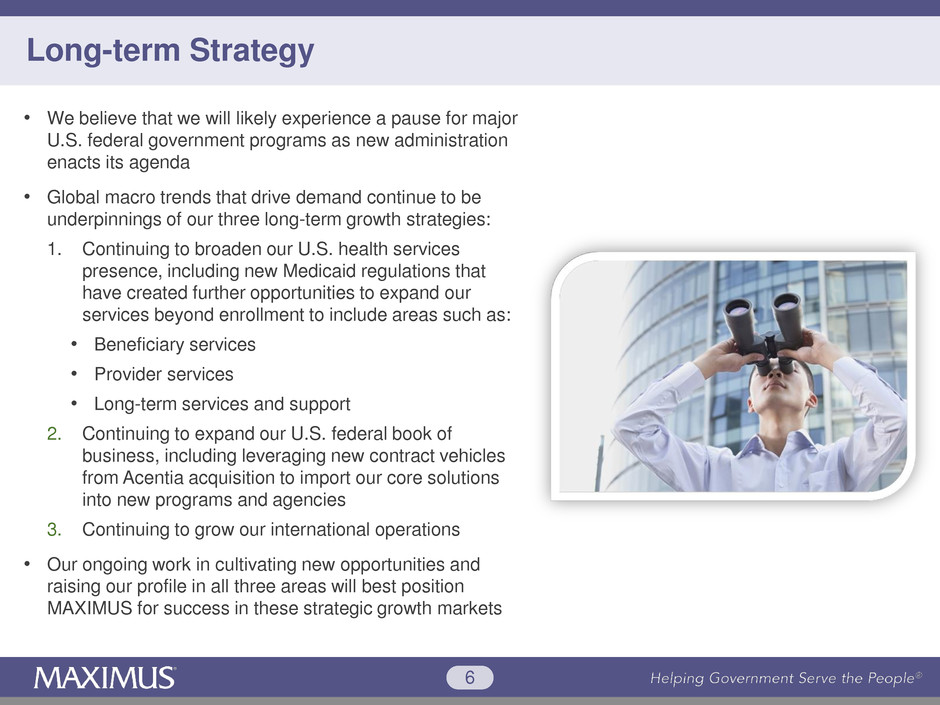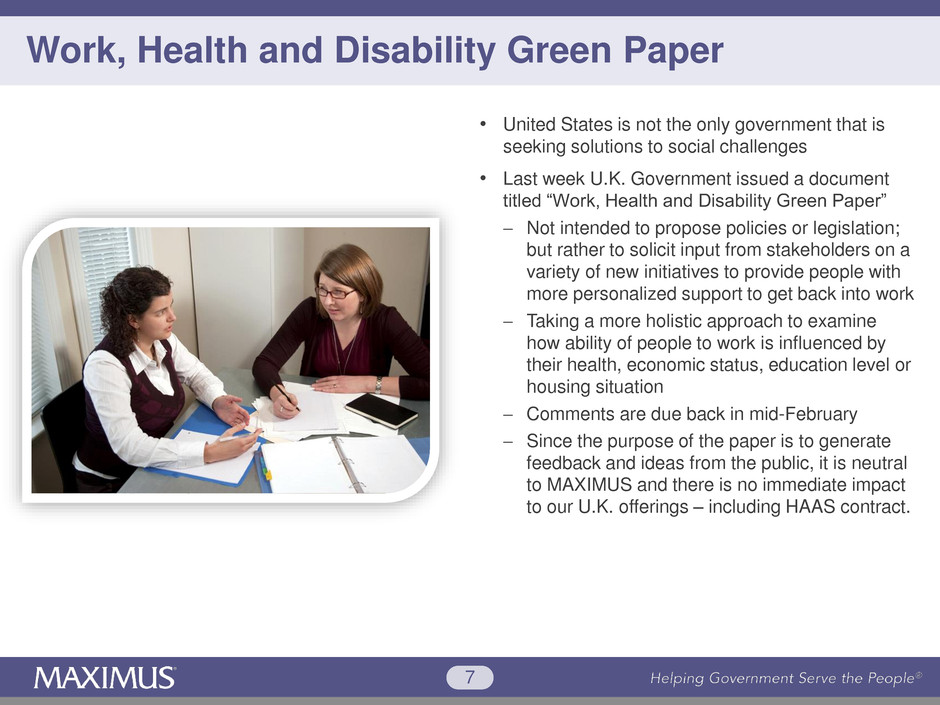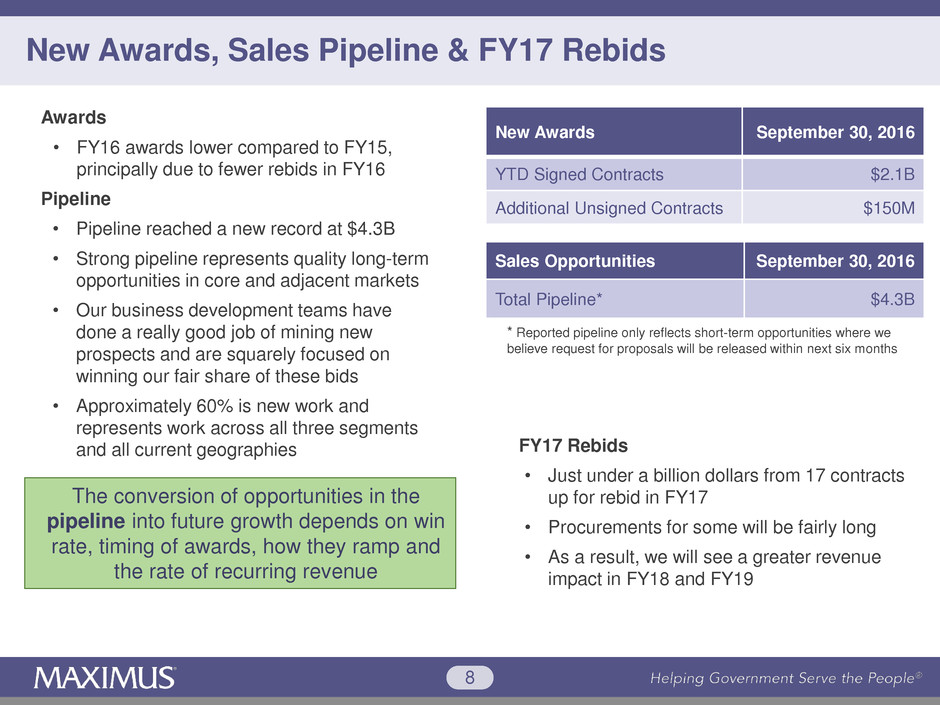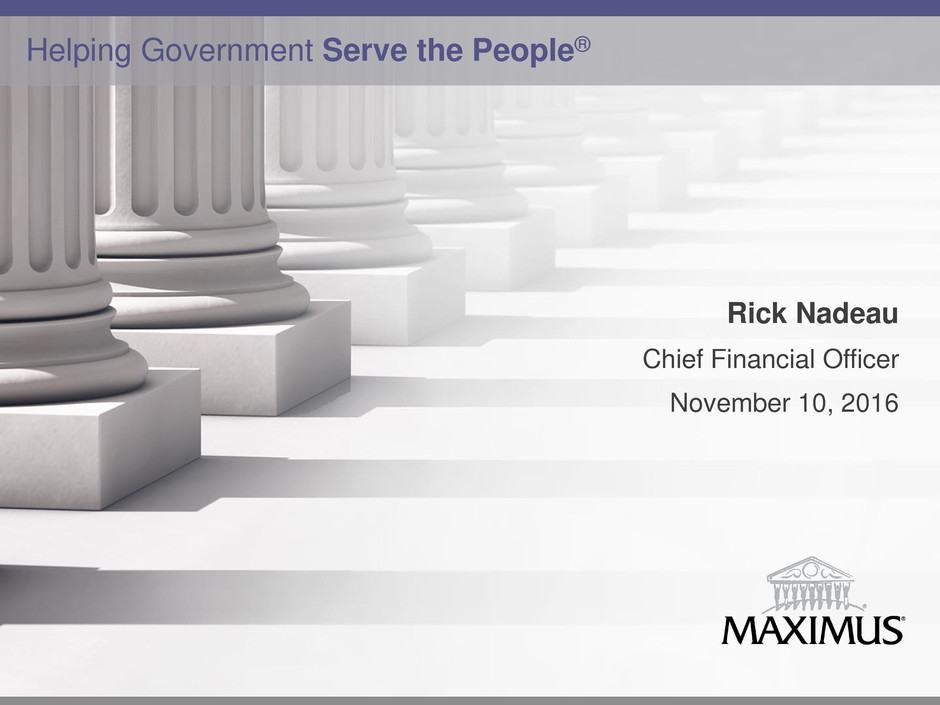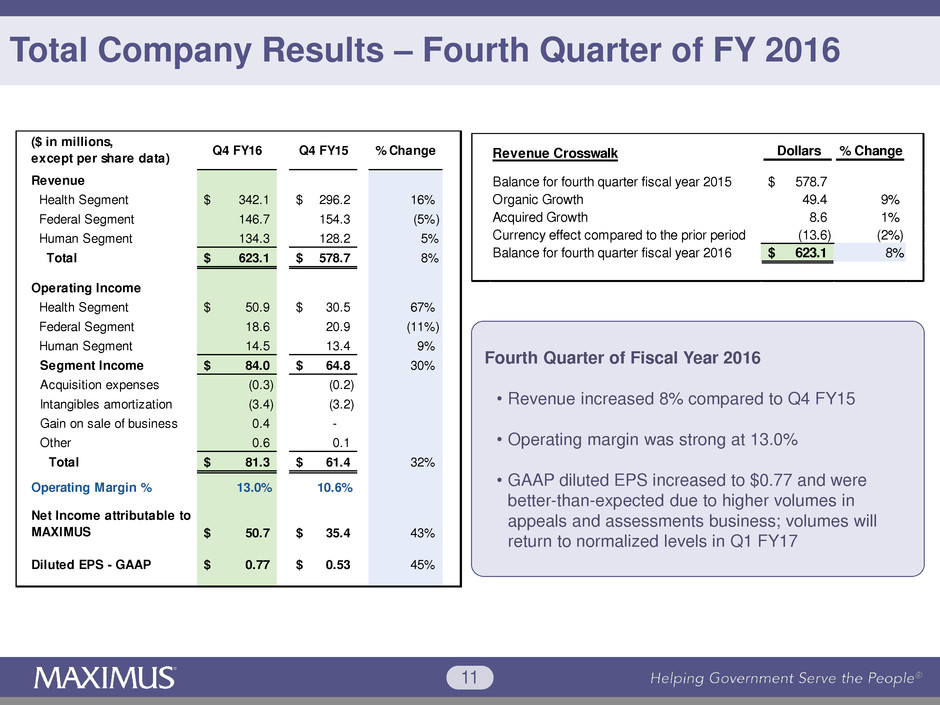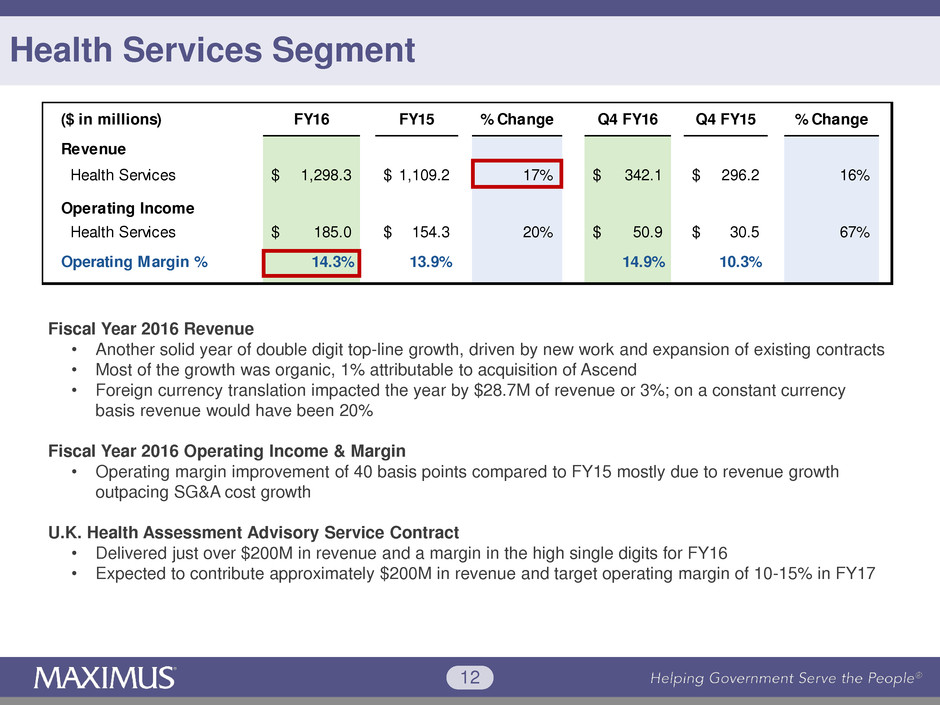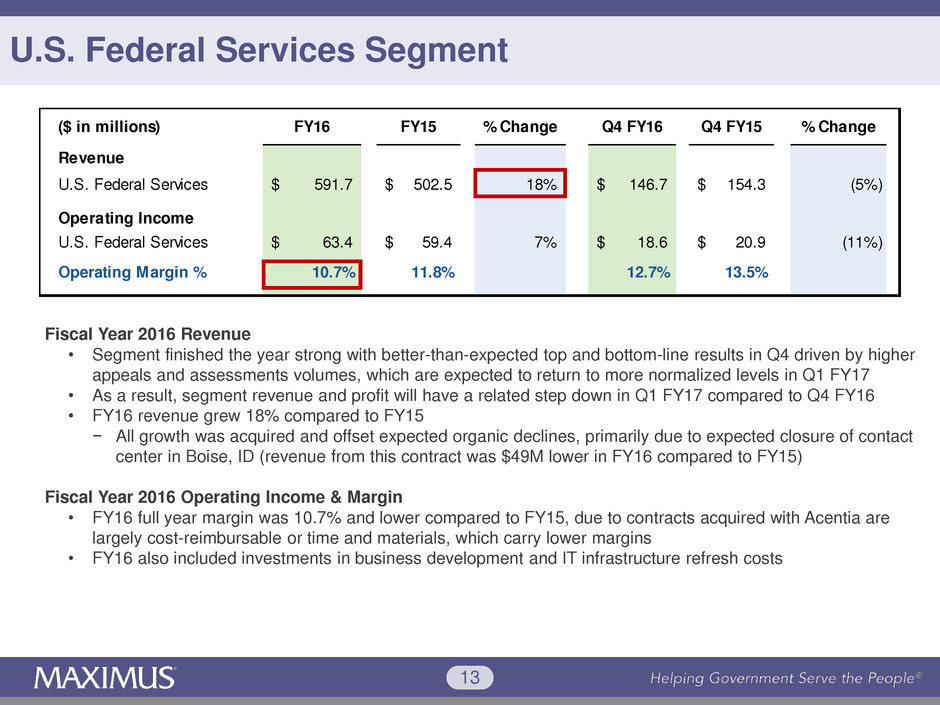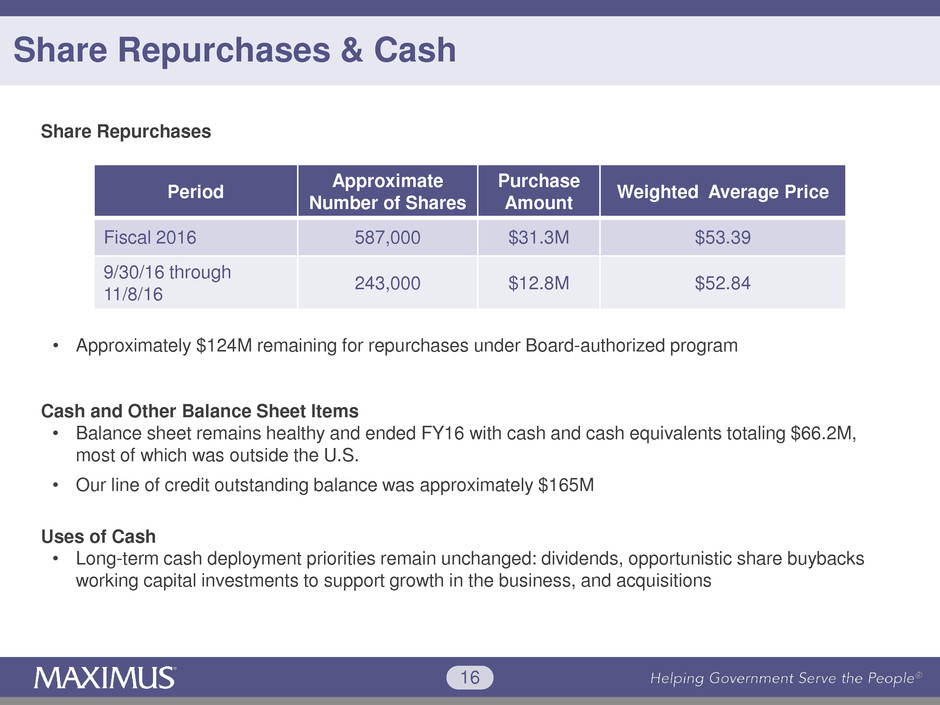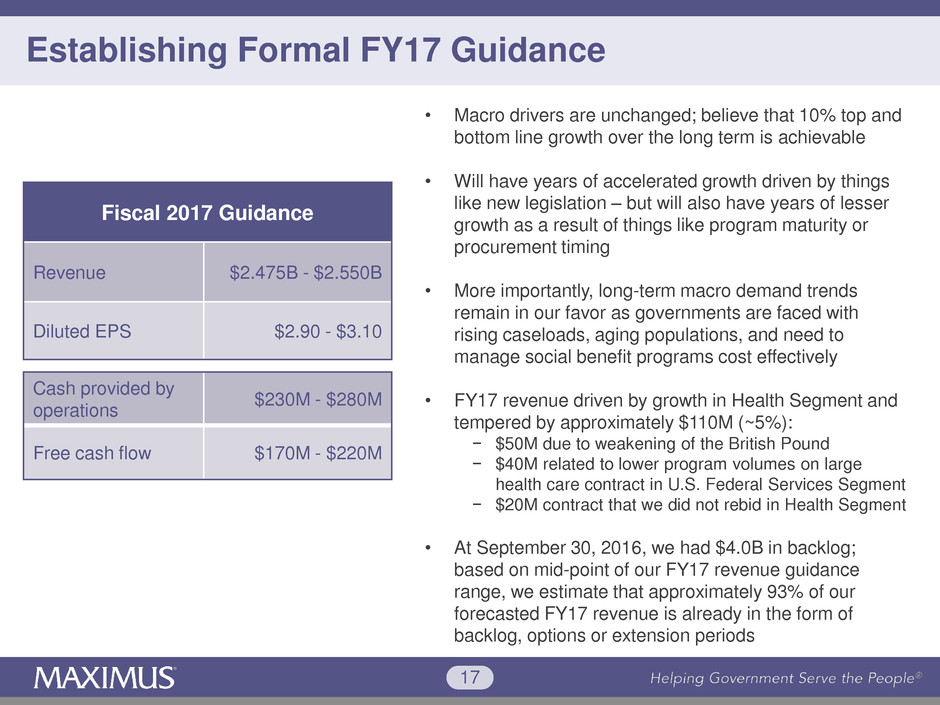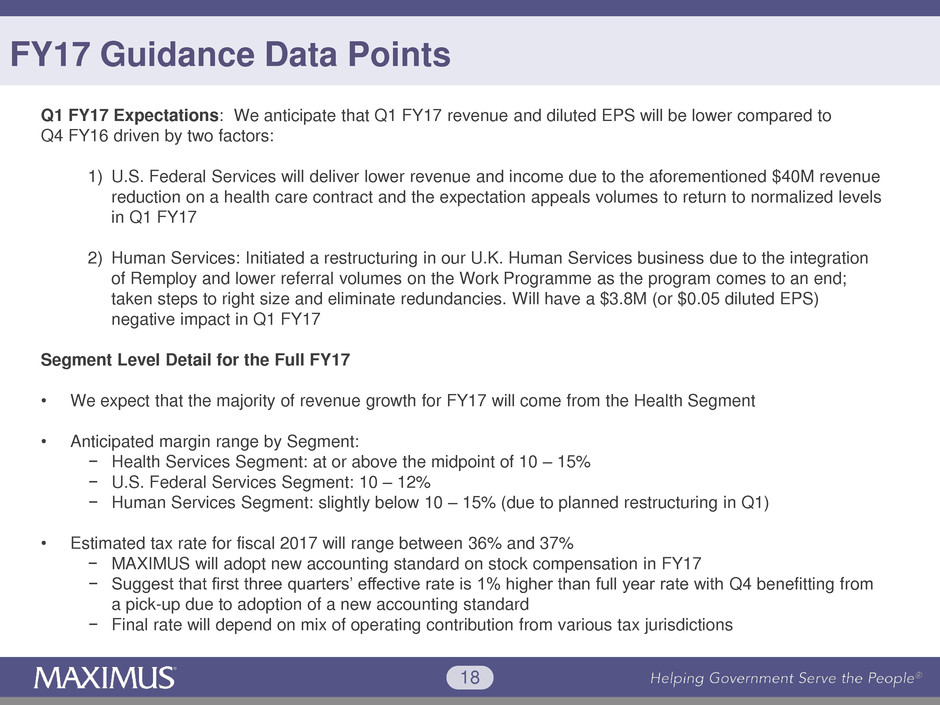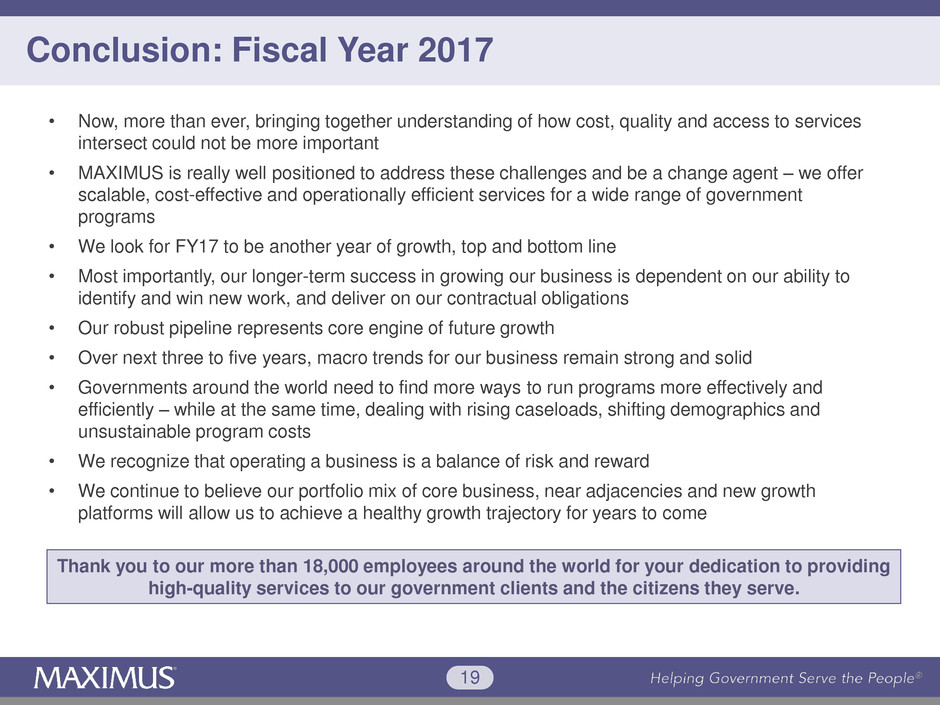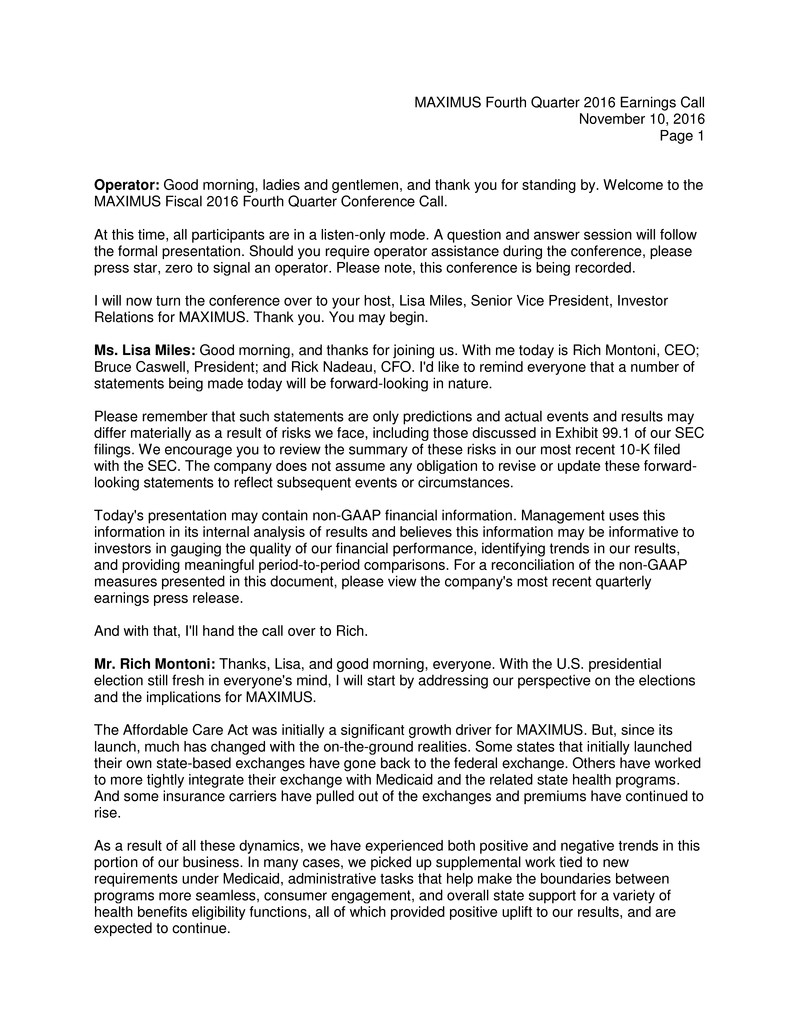
MAXIMUS Fourth Quarter 2016 Earnings Call
November 10, 2016
Page 1
Operator: Good morning, ladies and gentlemen, and thank you for standing by. Welcome to the
MAXIMUS Fiscal 2016 Fourth Quarter Conference Call.
At this time, all participants are in a listen-only mode. A question and answer session will follow
the formal presentation. Should you require operator assistance during the conference, please
press star, zero to signal an operator. Please note, this conference is being recorded.
I will now turn the conference over to your host, Lisa Miles, Senior Vice President, Investor
Relations for MAXIMUS. Thank you. You may begin.
Ms. Lisa Miles: Good morning, and thanks for joining us. With me today is Rich Montoni, CEO;
Bruce Caswell, President; and Rick Nadeau, CFO. I'd like to remind everyone that a number of
statements being made today will be forward-looking in nature.
Please remember that such statements are only predictions and actual events and results may
differ materially as a result of risks we face, including those discussed in Exhibit 99.1 of our SEC
filings. We encourage you to review the summary of these risks in our most recent 10-K filed
with the SEC. The company does not assume any obligation to revise or update these forward-
looking statements to reflect subsequent events or circumstances.
Today's presentation may contain non-GAAP financial information. Management uses this
information in its internal analysis of results and believes this information may be informative to
investors in gauging the quality of our financial performance, identifying trends in our results,
and providing meaningful period-to-period comparisons. For a reconciliation of the non-GAAP
measures presented in this document, please view the company's most recent quarterly
earnings press release.
And with that, I'll hand the call over to Rich.
Mr. Rich Montoni: Thanks, Lisa, and good morning, everyone. With the U.S. presidential
election still fresh in everyone's mind, I will start by addressing our perspective on the elections
and the implications for MAXIMUS.
The Affordable Care Act was initially a significant growth driver for MAXIMUS. But, since its
launch, much has changed with the on-the-ground realities. Some states that initially launched
their own state-based exchanges have gone back to the federal exchange. Others have worked
to more tightly integrate their exchange with Medicaid and the related state health programs.
And some insurance carriers have pulled out of the exchanges and premiums have continued to
rise.
As a result of all these dynamics, we have experienced both positive and negative trends in this
portion of our business. In many cases, we picked up supplemental work tied to new
requirements under Medicaid, administrative tasks that help make the boundaries between
programs more seamless, consumer engagement, and overall state support for a variety of
health benefits eligibility functions, all of which provided positive uplift to our results, and are
expected to continue.
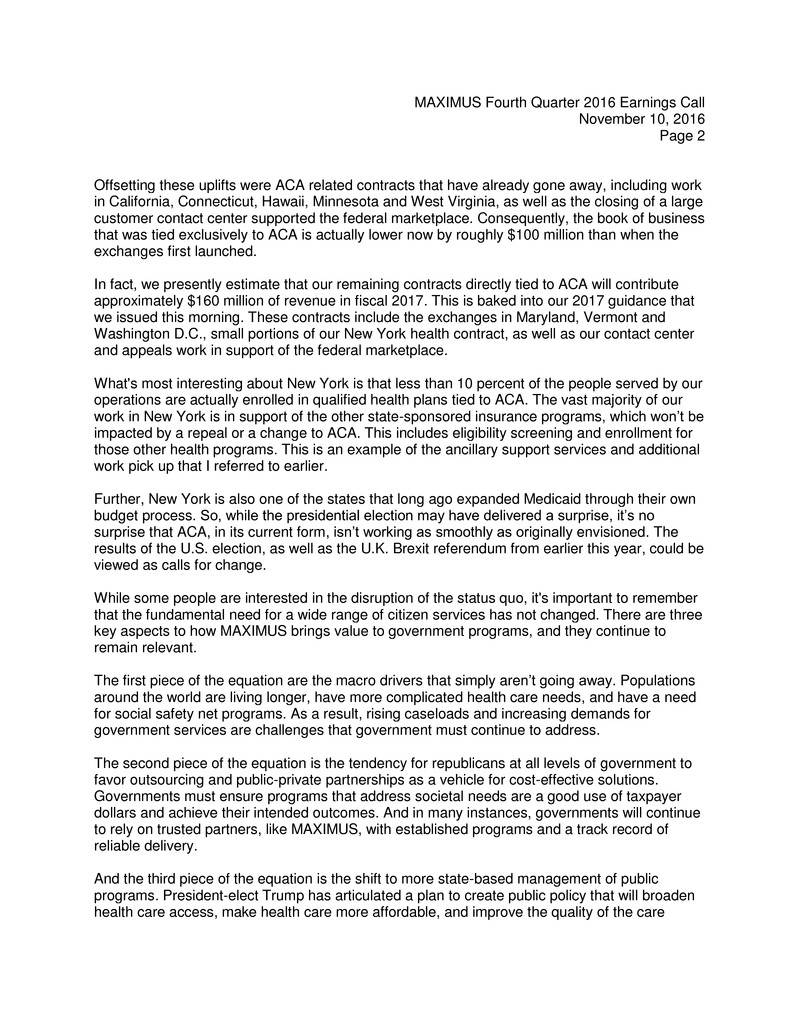
MAXIMUS Fourth Quarter 2016 Earnings Call
November 10, 2016
Page 2
Offsetting these uplifts were ACA related contracts that have already gone away, including work
in California, Connecticut, Hawaii, Minnesota and West Virginia, as well as the closing of a large
customer contact center supported the federal marketplace. Consequently, the book of business
that was tied exclusively to ACA is actually lower now by roughly $100 million than when the
exchanges first launched.
In fact, we presently estimate that our remaining contracts directly tied to ACA will contribute
approximately $160 million of revenue in fiscal 2017. This is baked into our 2017 guidance that
we issued this morning. These contracts include the exchanges in Maryland, Vermont and
Washington D.C., small portions of our New York health contract, as well as our contact center
and appeals work in support of the federal marketplace.
What's most interesting about New York is that less than 10 percent of the people served by our
operations are actually enrolled in qualified health plans tied to ACA. The vast majority of our
work in New York is in support of the other state-sponsored insurance programs, which won’t be
impacted by a repeal or a change to ACA. This includes eligibility screening and enrollment for
those other health programs. This is an example of the ancillary support services and additional
work pick up that I referred to earlier.
Further, New York is also one of the states that long ago expanded Medicaid through their own
budget process. So, while the presidential election may have delivered a surprise, it’s no
surprise that ACA, in its current form, isn’t working as smoothly as originally envisioned. The
results of the U.S. election, as well as the U.K. Brexit referendum from earlier this year, could be
viewed as calls for change.
While some people are interested in the disruption of the status quo, it's important to remember
that the fundamental need for a wide range of citizen services has not changed. There are three
key aspects to how MAXIMUS brings value to government programs, and they continue to
remain relevant.
The first piece of the equation are the macro drivers that simply aren’t going away. Populations
around the world are living longer, have more complicated health care needs, and have a need
for social safety net programs. As a result, rising caseloads and increasing demands for
government services are challenges that government must continue to address.
The second piece of the equation is the tendency for republicans at all levels of government to
favor outsourcing and public-private partnerships as a vehicle for cost-effective solutions.
Governments must ensure programs that address societal needs are a good use of taxpayer
dollars and achieve their intended outcomes. And in many instances, governments will continue
to rely on trusted partners, like MAXIMUS, with established programs and a track record of
reliable delivery.
And the third piece of the equation is the shift to more state-based management of public
programs. President-elect Trump has articulated a plan to create public policy that will broaden
health care access, make health care more affordable, and improve the quality of the care
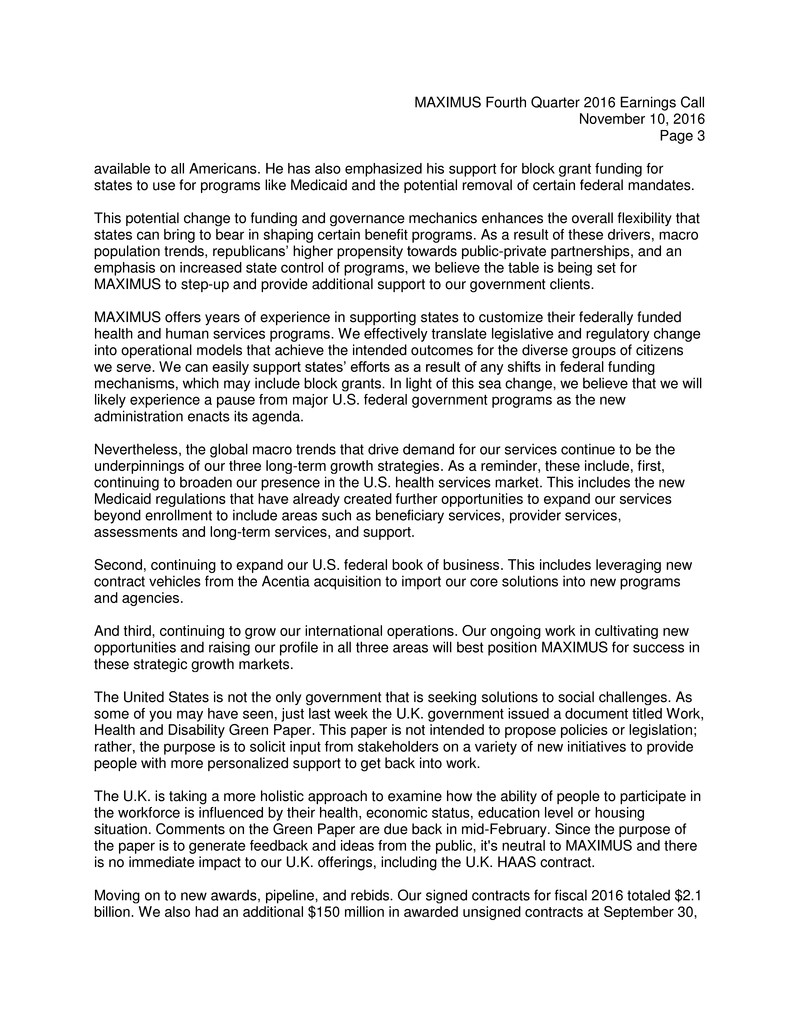
MAXIMUS Fourth Quarter 2016 Earnings Call
November 10, 2016
Page 3
available to all Americans. He has also emphasized his support for block grant funding for
states to use for programs like Medicaid and the potential removal of certain federal mandates.
This potential change to funding and governance mechanics enhances the overall flexibility that
states can bring to bear in shaping certain benefit programs. As a result of these drivers, macro
population trends, republicans’ higher propensity towards public-private partnerships, and an
emphasis on increased state control of programs, we believe the table is being set for
MAXIMUS to step-up and provide additional support to our government clients.
MAXIMUS offers years of experience in supporting states to customize their federally funded
health and human services programs. We effectively translate legislative and regulatory change
into operational models that achieve the intended outcomes for the diverse groups of citizens
we serve. We can easily support states’ efforts as a result of any shifts in federal funding
mechanisms, which may include block grants. In light of this sea change, we believe that we will
likely experience a pause from major U.S. federal government programs as the new
administration enacts its agenda.
Nevertheless, the global macro trends that drive demand for our services continue to be the
underpinnings of our three long-term growth strategies. As a reminder, these include, first,
continuing to broaden our presence in the U.S. health services market. This includes the new
Medicaid regulations that have already created further opportunities to expand our services
beyond enrollment to include areas such as beneficiary services, provider services,
assessments and long-term services, and support.
Second, continuing to expand our U.S. federal book of business. This includes leveraging new
contract vehicles from the Acentia acquisition to import our core solutions into new programs
and agencies.
And third, continuing to grow our international operations. Our ongoing work in cultivating new
opportunities and raising our profile in all three areas will best position MAXIMUS for success in
these strategic growth markets.
The United States is not the only government that is seeking solutions to social challenges. As
some of you may have seen, just last week the U.K. government issued a document titled Work,
Health and Disability Green Paper. This paper is not intended to propose policies or legislation;
rather, the purpose is to solicit input from stakeholders on a variety of new initiatives to provide
people with more personalized support to get back into work.
The U.K. is taking a more holistic approach to examine how the ability of people to participate in
the workforce is influenced by their health, economic status, education level or housing
situation. Comments on the Green Paper are due back in mid-February. Since the purpose of
the paper is to generate feedback and ideas from the public, it's neutral to MAXIMUS and there
is no immediate impact to our U.K. offerings, including the U.K. HAAS contract.
Moving on to new awards, pipeline, and rebids. Our signed contracts for fiscal 2016 totaled $2.1
billion. We also had an additional $150 million in awarded unsigned contracts at September 30,

MAXIMUS Fourth Quarter 2016 Earnings Call
November 10, 2016
Page 4
2016. As expected, fiscal 2016 awards came in lower compared to fiscal 2015, principally due to
low level of rebids in fiscal 2016.
Our pipeline of opportunities at September 30th remains robust. In fact, we reached a new
record at $4.3 billion. We are pleased with the strength of our pipeline and it represents quality
long-term opportunities in core and adjacent markets. Our business development teams are
aggressively mining new prospects and they are squarely focused on winning our fair share of
these bids.
Of the 4.3 billion pipeline, approximately 60 percent is new work and reflects opportunities
across all three segments and our current geographies. The record pipeline, including the new
opportunities therein, lay the ground work for future awards. The conversion of sales pipeline in
the future revenue growth will ultimately depend upon win rates, the timing of awards, how they
ramp up, and the rate of recurring revenue.
As we previously disclosed, we have just under $1 billion from 17 contracts that are up for rebid
in fiscal 2017. It's interesting to note that the procurements for some of these contracts will be
fairly long. As a result, we will see a greater revenue impact in fiscal 2018 and fiscal 2019. I'll
now turn the call over to Rick to discuss the financial results.
Mr. Rick Nadeau: Thanks, Rich. Overall, we are pleased to meet our objectives, and deliver a
record year of solid double-digit growth for both revenue and earnings. As most of you know, we
started fiscal year 2016 with some challenges on one of our largest contracts. At that time, the
management team said we would tackle these issues head-on. During the year, we took the
necessary steps to get the program on track, which allowed U.S. to deliver full-year earnings
towards the top-end of that range.
Revenue for fiscal year 2016 increased 14.5 percent over last year. Of this growth, 9 percent
was organic, driven by the health services segment, and 8 percent was acquired. All of this
growth was partially offset by a 2 percent decline tied to currency effects. On a constant-
currency basis, revenue would have increased 17 percent year-over-year. Total Company
operating margin for fiscal year 2016 was 11.9 percent, which, as expected, was tempered by
new programs and start-up.
For fiscal year 2016, net income attributable to MAXIMUS increased 13 percent. And GAAP
diluted earnings per share increased 14 percent to $2.69 compared to fiscal year 2015. This
included a net benefit of 3 cents from a gain of 6 cents from the sale of our education business,
legal costs of 2 cents related to a matter that occurred in 2014, and acquisition related expenses
of 1 cent. Excluding these items, diluted earnings per share for fiscal year 2016 would have
been $2.66.
Let me discuss results for the fourth quarter. Revenue grew 8 percent compared to last year. Of
this, approximately 9 percent was attributable to organic growth and 1 percent was acquired.
This growth was partially offset by a 2 percent decline, or approximately $13.6 million, related to
foreign currency exchange rates. On a constant-currency basis, total revenue would have grown
10 percent for the quarter. Fourth quarter operating margin was strong at 13 percent.
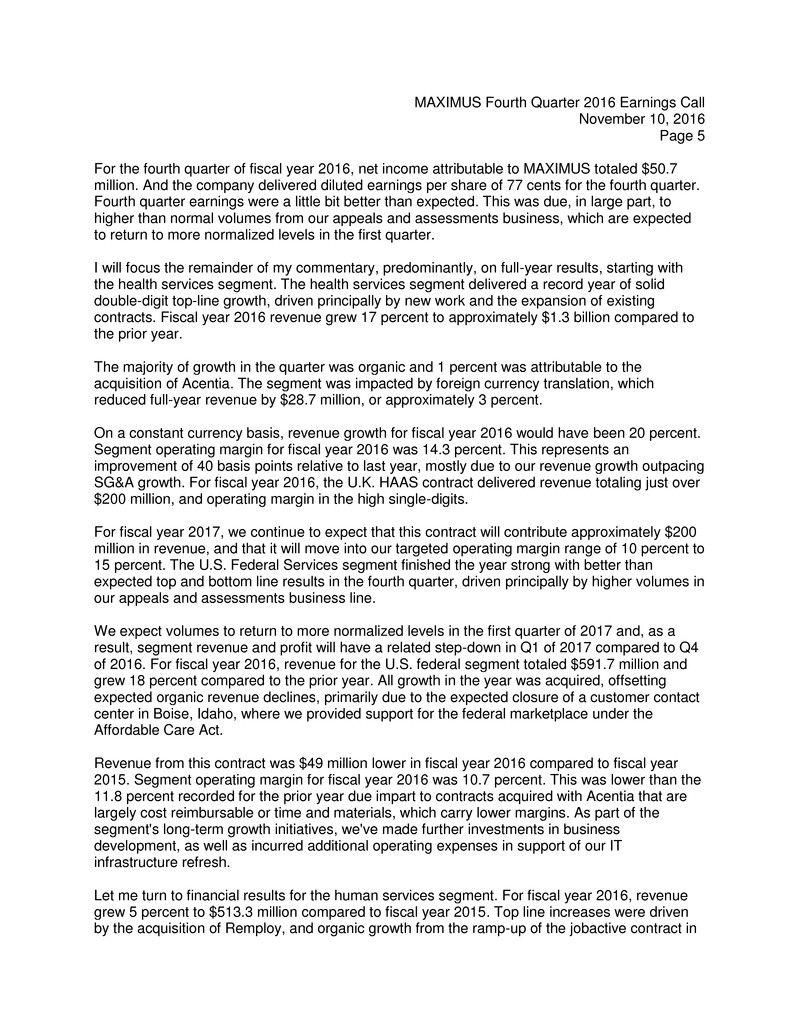
MAXIMUS Fourth Quarter 2016 Earnings Call
November 10, 2016
Page 5
For the fourth quarter of fiscal year 2016, net income attributable to MAXIMUS totaled $50.7
million. And the company delivered diluted earnings per share of 77 cents for the fourth quarter.
Fourth quarter earnings were a little bit better than expected. This was due, in large part, to
higher than normal volumes from our appeals and assessments business, which are expected
to return to more normalized levels in the first quarter.
I will focus the remainder of my commentary, predominantly, on full-year results, starting with
the health services segment. The health services segment delivered a record year of solid
double-digit top-line growth, driven principally by new work and the expansion of existing
contracts. Fiscal year 2016 revenue grew 17 percent to approximately $1.3 billion compared to
the prior year.
The majority of growth in the quarter was organic and 1 percent was attributable to the
acquisition of Acentia. The segment was impacted by foreign currency translation, which
reduced full-year revenue by $28.7 million, or approximately 3 percent.
On a constant currency basis, revenue growth for fiscal year 2016 would have been 20 percent.
Segment operating margin for fiscal year 2016 was 14.3 percent. This represents an
improvement of 40 basis points relative to last year, mostly due to our revenue growth outpacing
SG&A growth. For fiscal year 2016, the U.K. HAAS contract delivered revenue totaling just over
$200 million, and operating margin in the high single-digits.
For fiscal year 2017, we continue to expect that this contract will contribute approximately $200
million in revenue, and that it will move into our targeted operating margin range of 10 percent to
15 percent. The U.S. Federal Services segment finished the year strong with better than
expected top and bottom line results in the fourth quarter, driven principally by higher volumes in
our appeals and assessments business line.
We expect volumes to return to more normalized levels in the first quarter of 2017 and, as a
result, segment revenue and profit will have a related step-down in Q1 of 2017 compared to Q4
of 2016. For fiscal year 2016, revenue for the U.S. federal segment totaled $591.7 million and
grew 18 percent compared to the prior year. All growth in the year was acquired, offsetting
expected organic revenue declines, primarily due to the expected closure of a customer contact
center in Boise, Idaho, where we provided support for the federal marketplace under the
Affordable Care Act.
Revenue from this contract was $49 million lower in fiscal year 2016 compared to fiscal year
2015. Segment operating margin for fiscal year 2016 was 10.7 percent. This was lower than the
11.8 percent recorded for the prior year due impart to contracts acquired with Acentia that are
largely cost reimbursable or time and materials, which carry lower margins. As part of the
segment's long-term growth initiatives, we've made further investments in business
development, as well as incurred additional operating expenses in support of our IT
infrastructure refresh.
Let me turn to financial results for the human services segment. For fiscal year 2016, revenue
grew 5 percent to $513.3 million compared to fiscal year 2015. Top line increases were driven
by the acquisition of Remploy, and organic growth from the ramp-up of the jobactive contract in
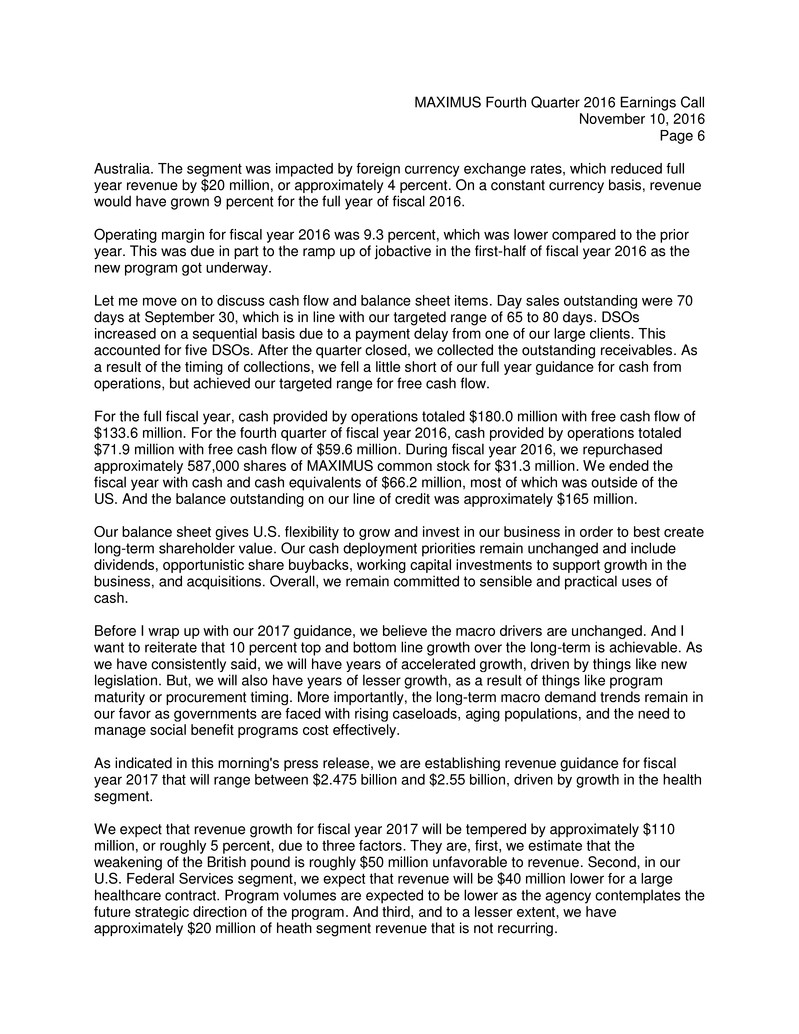
MAXIMUS Fourth Quarter 2016 Earnings Call
November 10, 2016
Page 6
Australia. The segment was impacted by foreign currency exchange rates, which reduced full
year revenue by $20 million, or approximately 4 percent. On a constant currency basis, revenue
would have grown 9 percent for the full year of fiscal 2016.
Operating margin for fiscal year 2016 was 9.3 percent, which was lower compared to the prior
year. This was due in part to the ramp up of jobactive in the first-half of fiscal year 2016 as the
new program got underway.
Let me move on to discuss cash flow and balance sheet items. Day sales outstanding were 70
days at September 30, which is in line with our targeted range of 65 to 80 days. DSOs
increased on a sequential basis due to a payment delay from one of our large clients. This
accounted for five DSOs. After the quarter closed, we collected the outstanding receivables. As
a result of the timing of collections, we fell a little short of our full year guidance for cash from
operations, but achieved our targeted range for free cash flow.
For the full fiscal year, cash provided by operations totaled $180.0 million with free cash flow of
$133.6 million. For the fourth quarter of fiscal year 2016, cash provided by operations totaled
$71.9 million with free cash flow of $59.6 million. During fiscal year 2016, we repurchased
approximately 587,000 shares of MAXIMUS common stock for $31.3 million. We ended the
fiscal year with cash and cash equivalents of $66.2 million, most of which was outside of the
US. And the balance outstanding on our line of credit was approximately $165 million.
Our balance sheet gives U.S. flexibility to grow and invest in our business in order to best create
long-term shareholder value. Our cash deployment priorities remain unchanged and include
dividends, opportunistic share buybacks, working capital investments to support growth in the
business, and acquisitions. Overall, we remain committed to sensible and practical uses of
cash.
Before I wrap up with our 2017 guidance, we believe the macro drivers are unchanged. And I
want to reiterate that 10 percent top and bottom line growth over the long-term is achievable. As
we have consistently said, we will have years of accelerated growth, driven by things like new
legislation. But, we will also have years of lesser growth, as a result of things like program
maturity or procurement timing. More importantly, the long-term macro demand trends remain in
our favor as governments are faced with rising caseloads, aging populations, and the need to
manage social benefit programs cost effectively.
As indicated in this morning's press release, we are establishing revenue guidance for fiscal
year 2017 that will range between $2.475 billion and $2.55 billion, driven by growth in the health
segment.
We expect that revenue growth for fiscal year 2017 will be tempered by approximately $110
million, or roughly 5 percent, due to three factors. They are, first, we estimate that the
weakening of the British pound is roughly $50 million unfavorable to revenue. Second, in our
U.S. Federal Services segment, we expect that revenue will be $40 million lower for a large
healthcare contract. Program volumes are expected to be lower as the agency contemplates the
future strategic direction of the program. And third, and to a lesser extent, we have
approximately $20 million of heath segment revenue that is not recurring.
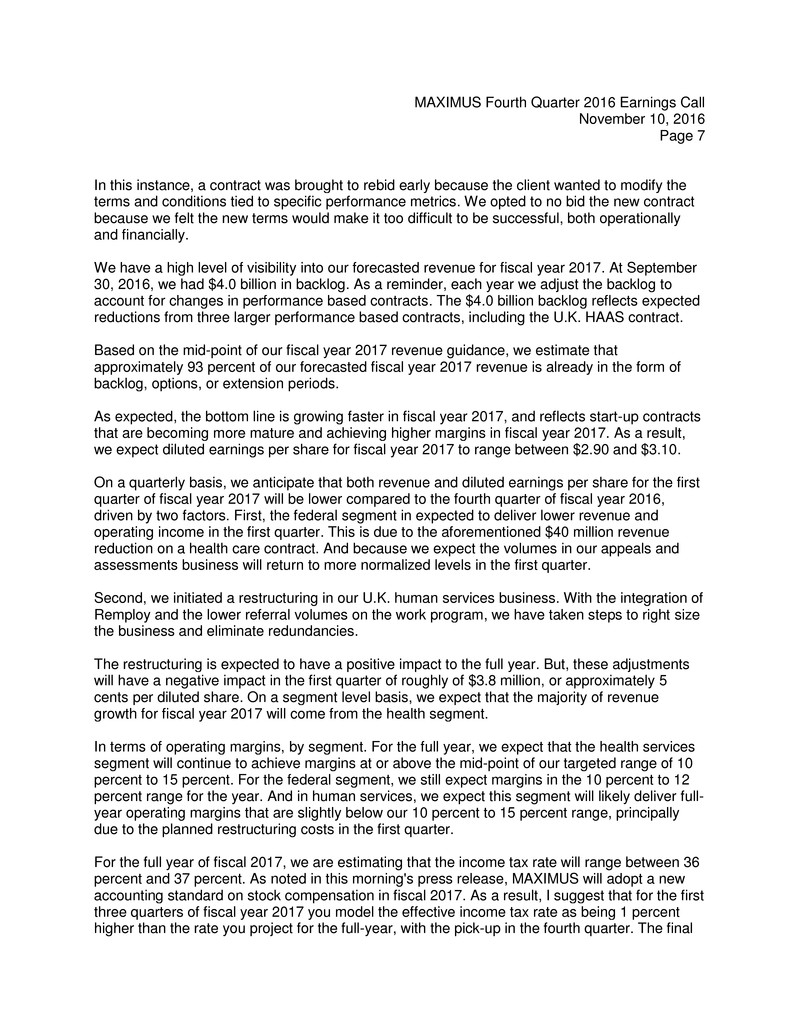
MAXIMUS Fourth Quarter 2016 Earnings Call
November 10, 2016
Page 7
In this instance, a contract was brought to rebid early because the client wanted to modify the
terms and conditions tied to specific performance metrics. We opted to no bid the new contract
because we felt the new terms would make it too difficult to be successful, both operationally
and financially.
We have a high level of visibility into our forecasted revenue for fiscal year 2017. At September
30, 2016, we had $4.0 billion in backlog. As a reminder, each year we adjust the backlog to
account for changes in performance based contracts. The $4.0 billion backlog reflects expected
reductions from three larger performance based contracts, including the U.K. HAAS contract.
Based on the mid-point of our fiscal year 2017 revenue guidance, we estimate that
approximately 93 percent of our forecasted fiscal year 2017 revenue is already in the form of
backlog, options, or extension periods.
As expected, the bottom line is growing faster in fiscal year 2017, and reflects start-up contracts
that are becoming more mature and achieving higher margins in fiscal year 2017. As a result,
we expect diluted earnings per share for fiscal year 2017 to range between $2.90 and $3.10.
On a quarterly basis, we anticipate that both revenue and diluted earnings per share for the first
quarter of fiscal year 2017 will be lower compared to the fourth quarter of fiscal year 2016,
driven by two factors. First, the federal segment in expected to deliver lower revenue and
operating income in the first quarter. This is due to the aforementioned $40 million revenue
reduction on a health care contract. And because we expect the volumes in our appeals and
assessments business will return to more normalized levels in the first quarter.
Second, we initiated a restructuring in our U.K. human services business. With the integration of
Remploy and the lower referral volumes on the work program, we have taken steps to right size
the business and eliminate redundancies.
The restructuring is expected to have a positive impact to the full year. But, these adjustments
will have a negative impact in the first quarter of roughly of $3.8 million, or approximately 5
cents per diluted share. On a segment level basis, we expect that the majority of revenue
growth for fiscal year 2017 will come from the health segment.
In terms of operating margins, by segment. For the full year, we expect that the health services
segment will continue to achieve margins at or above the mid-point of our targeted range of 10
percent to 15 percent. For the federal segment, we still expect margins in the 10 percent to 12
percent range for the year. And in human services, we expect this segment will likely deliver full-
year operating margins that are slightly below our 10 percent to 15 percent range, principally
due to the planned restructuring costs in the first quarter.
For the full year of fiscal 2017, we are estimating that the income tax rate will range between 36
percent and 37 percent. As noted in this morning's press release, MAXIMUS will adopt a new
accounting standard on stock compensation in fiscal 2017. As a result, I suggest that for the first
three quarters of fiscal year 2017 you model the effective income tax rate as being 1 percent
higher than the rate you project for the full-year, with the pick-up in the fourth quarter. The final
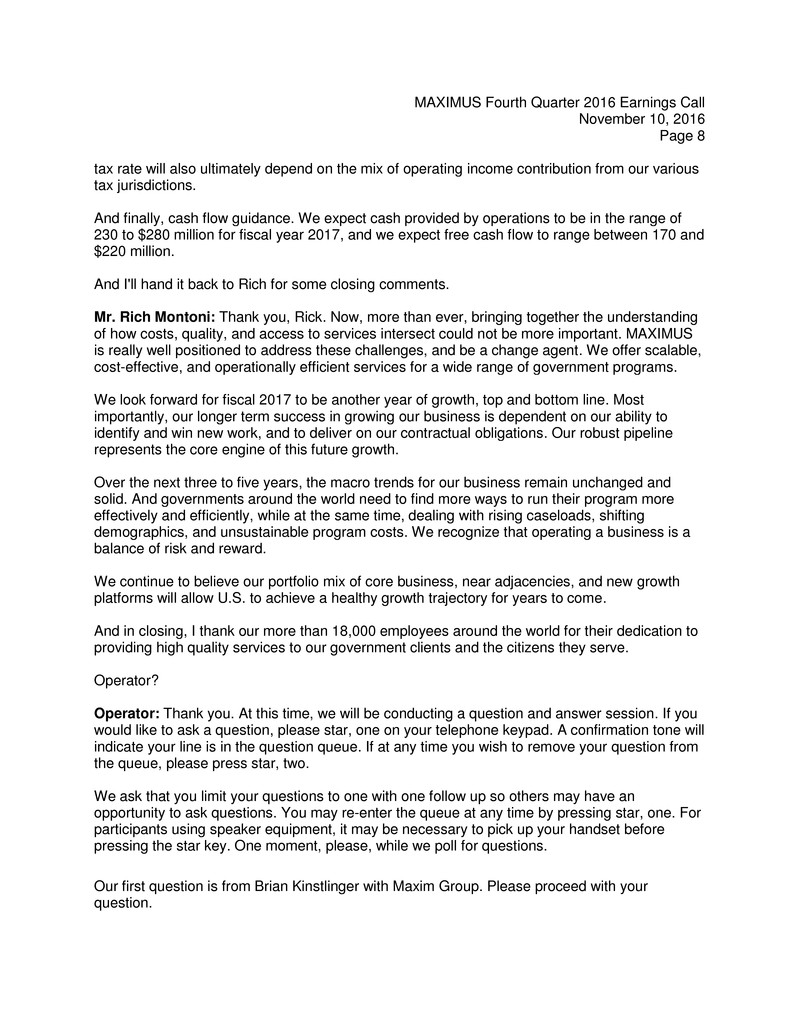
MAXIMUS Fourth Quarter 2016 Earnings Call
November 10, 2016
Page 8
tax rate will also ultimately depend on the mix of operating income contribution from our various
tax jurisdictions.
And finally, cash flow guidance. We expect cash provided by operations to be in the range of
230 to $280 million for fiscal year 2017, and we expect free cash flow to range between 170 and
$220 million.
And I'll hand it back to Rich for some closing comments.
Mr. Rich Montoni: Thank you, Rick. Now, more than ever, bringing together the understanding
of how costs, quality, and access to services intersect could not be more important. MAXIMUS
is really well positioned to address these challenges, and be a change agent. We offer scalable,
cost-effective, and operationally efficient services for a wide range of government programs.
We look forward for fiscal 2017 to be another year of growth, top and bottom line. Most
importantly, our longer term success in growing our business is dependent on our ability to
identify and win new work, and to deliver on our contractual obligations. Our robust pipeline
represents the core engine of this future growth.
Over the next three to five years, the macro trends for our business remain unchanged and
solid. And governments around the world need to find more ways to run their program more
effectively and efficiently, while at the same time, dealing with rising caseloads, shifting
demographics, and unsustainable program costs. We recognize that operating a business is a
balance of risk and reward.
We continue to believe our portfolio mix of core business, near adjacencies, and new growth
platforms will allow U.S. to achieve a healthy growth trajectory for years to come.
And in closing, I thank our more than 18,000 employees around the world for their dedication to
providing high quality services to our government clients and the citizens they serve.
Operator?
Operator: Thank you. At this time, we will be conducting a question and answer session. If you
would like to ask a question, please star, one on your telephone keypad. A confirmation tone will
indicate your line is in the question queue. If at any time you wish to remove your question from
the queue, please press star, two.
We ask that you limit your questions to one with one follow up so others may have an
opportunity to ask questions. You may re-enter the queue at any time by pressing star, one. For
participants using speaker equipment, it may be necessary to pick up your handset before
pressing the star key. One moment, please, while we poll for questions.
Our first question is from Brian Kinstlinger with Maxim Group. Please proceed with your
question.
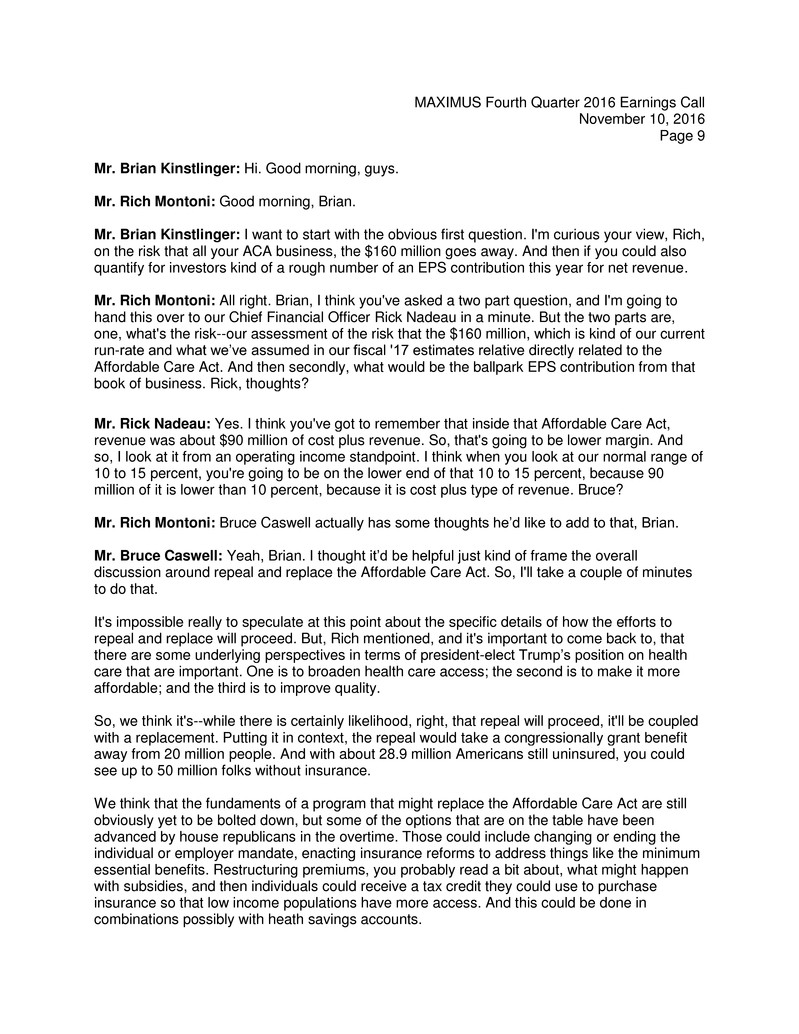
MAXIMUS Fourth Quarter 2016 Earnings Call
November 10, 2016
Page 9
Mr. Brian Kinstlinger: Hi. Good morning, guys.
Mr. Rich Montoni: Good morning, Brian.
Mr. Brian Kinstlinger: I want to start with the obvious first question. I'm curious your view, Rich,
on the risk that all your ACA business, the $160 million goes away. And then if you could also
quantify for investors kind of a rough number of an EPS contribution this year for net revenue.
Mr. Rich Montoni: All right. Brian, I think you've asked a two part question, and I'm going to
hand this over to our Chief Financial Officer Rick Nadeau in a minute. But the two parts are,
one, what's the risk--our assessment of the risk that the $160 million, which is kind of our current
run-rate and what we’ve assumed in our fiscal '17 estimates relative directly related to the
Affordable Care Act. And then secondly, what would be the ballpark EPS contribution from that
book of business. Rick, thoughts?
Mr. Rick Nadeau: Yes. I think you've got to remember that inside that Affordable Care Act,
revenue was about $90 million of cost plus revenue. So, that's going to be lower margin. And
so, I look at it from an operating income standpoint. I think when you look at our normal range of
10 to 15 percent, you're going to be on the lower end of that 10 to 15 percent, because 90
million of it is lower than 10 percent, because it is cost plus type of revenue. Bruce?
Mr. Rich Montoni: Bruce Caswell actually has some thoughts he’d like to add to that, Brian.
Mr. Bruce Caswell: Yeah, Brian. I thought it’d be helpful just kind of frame the overall
discussion around repeal and replace the Affordable Care Act. So, I'll take a couple of minutes
to do that.
It's impossible really to speculate at this point about the specific details of how the efforts to
repeal and replace will proceed. But, Rich mentioned, and it's important to come back to, that
there are some underlying perspectives in terms of president-elect Trump’s position on health
care that are important. One is to broaden health care access; the second is to make it more
affordable; and the third is to improve quality.
So, we think it's--while there is certainly likelihood, right, that repeal will proceed, it'll be coupled
with a replacement. Putting it in context, the repeal would take a congressionally grant benefit
away from 20 million people. And with about 28.9 million Americans still uninsured, you could
see up to 50 million folks without insurance.
We think that the fundaments of a program that might replace the Affordable Care Act are still
obviously yet to be bolted down, but some of the options that are on the table have been
advanced by house republicans in the overtime. Those could include changing or ending the
individual or employer mandate, enacting insurance reforms to address things like the minimum
essential benefits. Restructuring premiums, you probably read a bit about, what might happen
with subsidies, and then individuals could receive a tax credit they could use to purchase
insurance so that low income populations have more access. And this could be done in
combinations possibly with heath savings accounts.
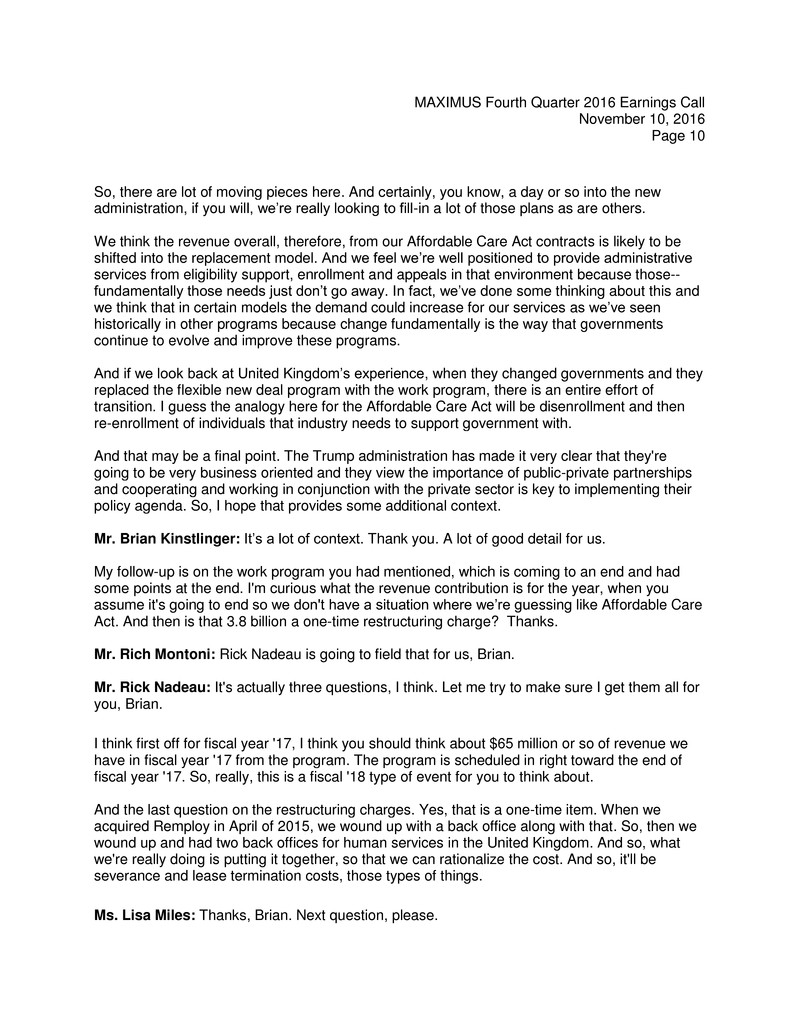
MAXIMUS Fourth Quarter 2016 Earnings Call
November 10, 2016
Page 10
So, there are lot of moving pieces here. And certainly, you know, a day or so into the new
administration, if you will, we’re really looking to fill-in a lot of those plans as are others.
We think the revenue overall, therefore, from our Affordable Care Act contracts is likely to be
shifted into the replacement model. And we feel we’re well positioned to provide administrative
services from eligibility support, enrollment and appeals in that environment because those--
fundamentally those needs just don’t go away. In fact, we’ve done some thinking about this and
we think that in certain models the demand could increase for our services as we’ve seen
historically in other programs because change fundamentally is the way that governments
continue to evolve and improve these programs.
And if we look back at United Kingdom’s experience, when they changed governments and they
replaced the flexible new deal program with the work program, there is an entire effort of
transition. I guess the analogy here for the Affordable Care Act will be disenrollment and then
re-enrollment of individuals that industry needs to support government with.
And that may be a final point. The Trump administration has made it very clear that they're
going to be very business oriented and they view the importance of public-private partnerships
and cooperating and working in conjunction with the private sector is key to implementing their
policy agenda. So, I hope that provides some additional context.
Mr. Brian Kinstlinger: It’s a lot of context. Thank you. A lot of good detail for us.
My follow-up is on the work program you had mentioned, which is coming to an end and had
some points at the end. I'm curious what the revenue contribution is for the year, when you
assume it's going to end so we don't have a situation where we’re guessing like Affordable Care
Act. And then is that 3.8 billion a one-time restructuring charge? Thanks.
Mr. Rich Montoni: Rick Nadeau is going to field that for us, Brian.
Mr. Rick Nadeau: It's actually three questions, I think. Let me try to make sure I get them all for
you, Brian.
I think first off for fiscal year '17, I think you should think about $65 million or so of revenue we
have in fiscal year '17 from the program. The program is scheduled in right toward the end of
fiscal year '17. So, really, this is a fiscal '18 type of event for you to think about.
And the last question on the restructuring charges. Yes, that is a one-time item. When we
acquired Remploy in April of 2015, we wound up with a back office along with that. So, then we
wound up and had two back offices for human services in the United Kingdom. And so, what
we're really doing is putting it together, so that we can rationalize the cost. And so, it'll be
severance and lease termination costs, those types of things.
Ms. Lisa Miles: Thanks, Brian. Next question, please.
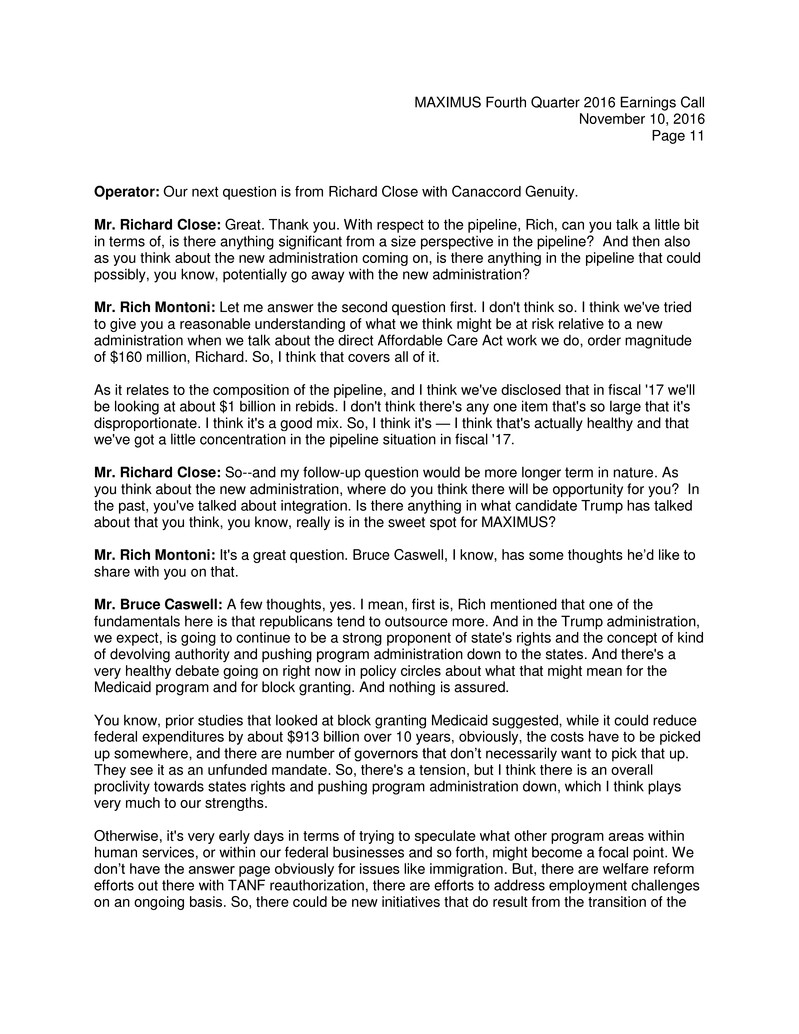
MAXIMUS Fourth Quarter 2016 Earnings Call
November 10, 2016
Page 11
Operator: Our next question is from Richard Close with Canaccord Genuity.
Mr. Richard Close: Great. Thank you. With respect to the pipeline, Rich, can you talk a little bit
in terms of, is there anything significant from a size perspective in the pipeline? And then also
as you think about the new administration coming on, is there anything in the pipeline that could
possibly, you know, potentially go away with the new administration?
Mr. Rich Montoni: Let me answer the second question first. I don't think so. I think we've tried
to give you a reasonable understanding of what we think might be at risk relative to a new
administration when we talk about the direct Affordable Care Act work we do, order magnitude
of $160 million, Richard. So, I think that covers all of it.
As it relates to the composition of the pipeline, and I think we've disclosed that in fiscal '17 we'll
be looking at about $1 billion in rebids. I don't think there's any one item that's so large that it's
disproportionate. I think it's a good mix. So, I think it's — I think that's actually healthy and that
we've got a little concentration in the pipeline situation in fiscal '17.
Mr. Richard Close: So--and my follow-up question would be more longer term in nature. As
you think about the new administration, where do you think there will be opportunity for you? In
the past, you've talked about integration. Is there anything in what candidate Trump has talked
about that you think, you know, really is in the sweet spot for MAXIMUS?
Mr. Rich Montoni: It's a great question. Bruce Caswell, I know, has some thoughts he’d like to
share with you on that.
Mr. Bruce Caswell: A few thoughts, yes. I mean, first is, Rich mentioned that one of the
fundamentals here is that republicans tend to outsource more. And in the Trump administration,
we expect, is going to continue to be a strong proponent of state's rights and the concept of kind
of devolving authority and pushing program administration down to the states. And there's a
very healthy debate going on right now in policy circles about what that might mean for the
Medicaid program and for block granting. And nothing is assured.
You know, prior studies that looked at block granting Medicaid suggested, while it could reduce
federal expenditures by about $913 billion over 10 years, obviously, the costs have to be picked
up somewhere, and there are number of governors that don’t necessarily want to pick that up.
They see it as an unfunded mandate. So, there's a tension, but I think there is an overall
proclivity towards states rights and pushing program administration down, which I think plays
very much to our strengths.
Otherwise, it's very early days in terms of trying to speculate what other program areas within
human services, or within our federal businesses and so forth, might become a focal point. We
don’t have the answer page obviously for issues like immigration. But, there are welfare reform
efforts out there with TANF reauthorization, there are efforts to address employment challenges
on an ongoing basis. So, there could be new initiatives that do result from the transition of the
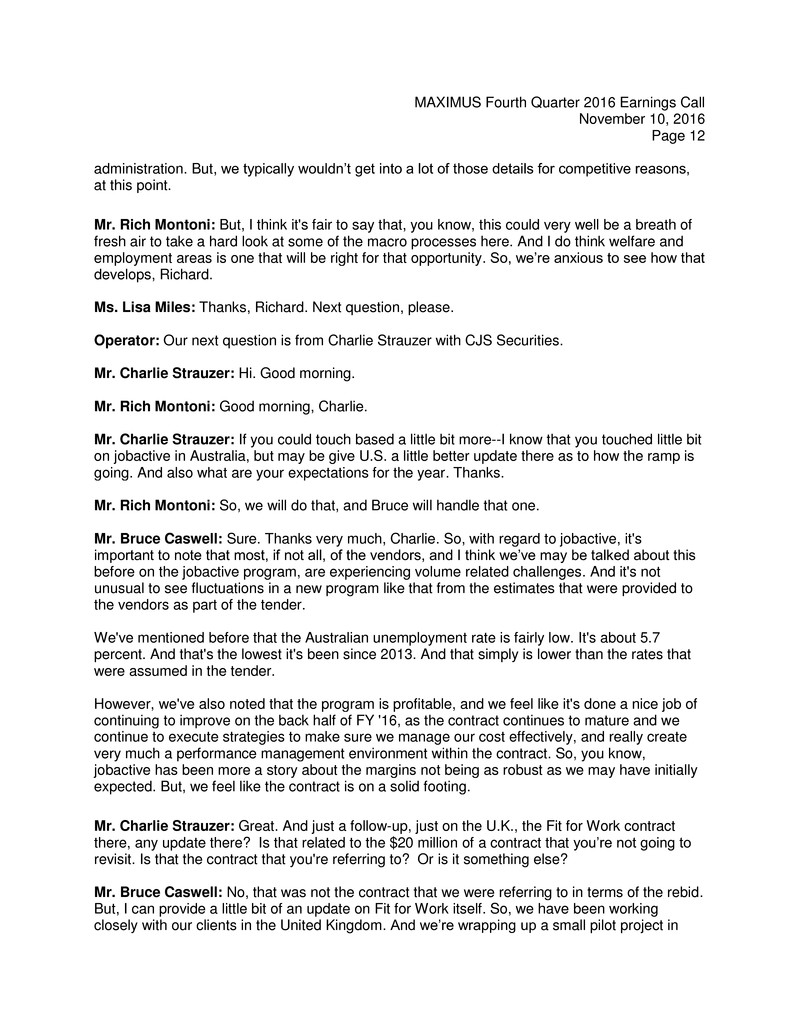
MAXIMUS Fourth Quarter 2016 Earnings Call
November 10, 2016
Page 12
administration. But, we typically wouldn’t get into a lot of those details for competitive reasons,
at this point.
Mr. Rich Montoni: But, I think it's fair to say that, you know, this could very well be a breath of
fresh air to take a hard look at some of the macro processes here. And I do think welfare and
employment areas is one that will be right for that opportunity. So, we’re anxious to see how that
develops, Richard.
Ms. Lisa Miles: Thanks, Richard. Next question, please.
Operator: Our next question is from Charlie Strauzer with CJS Securities.
Mr. Charlie Strauzer: Hi. Good morning.
Mr. Rich Montoni: Good morning, Charlie.
Mr. Charlie Strauzer: If you could touch based a little bit more--I know that you touched little bit
on jobactive in Australia, but may be give U.S. a little better update there as to how the ramp is
going. And also what are your expectations for the year. Thanks.
Mr. Rich Montoni: So, we will do that, and Bruce will handle that one.
Mr. Bruce Caswell: Sure. Thanks very much, Charlie. So, with regard to jobactive, it's
important to note that most, if not all, of the vendors, and I think we’ve may be talked about this
before on the jobactive program, are experiencing volume related challenges. And it's not
unusual to see fluctuations in a new program like that from the estimates that were provided to
the vendors as part of the tender.
We've mentioned before that the Australian unemployment rate is fairly low. It's about 5.7
percent. And that's the lowest it's been since 2013. And that simply is lower than the rates that
were assumed in the tender.
However, we've also noted that the program is profitable, and we feel like it's done a nice job of
continuing to improve on the back half of FY '16, as the contract continues to mature and we
continue to execute strategies to make sure we manage our cost effectively, and really create
very much a performance management environment within the contract. So, you know,
jobactive has been more a story about the margins not being as robust as we may have initially
expected. But, we feel like the contract is on a solid footing.
Mr. Charlie Strauzer: Great. And just a follow-up, just on the U.K., the Fit for Work contract
there, any update there? Is that related to the $20 million of a contract that you’re not going to
revisit. Is that the contract that you're referring to? Or is it something else?
Mr. Bruce Caswell: No, that was not the contract that we were referring to in terms of the rebid.
But, I can provide a little bit of an update on Fit for Work itself. So, we have been working
closely with our clients in the United Kingdom. And we’re wrapping up a small pilot project in
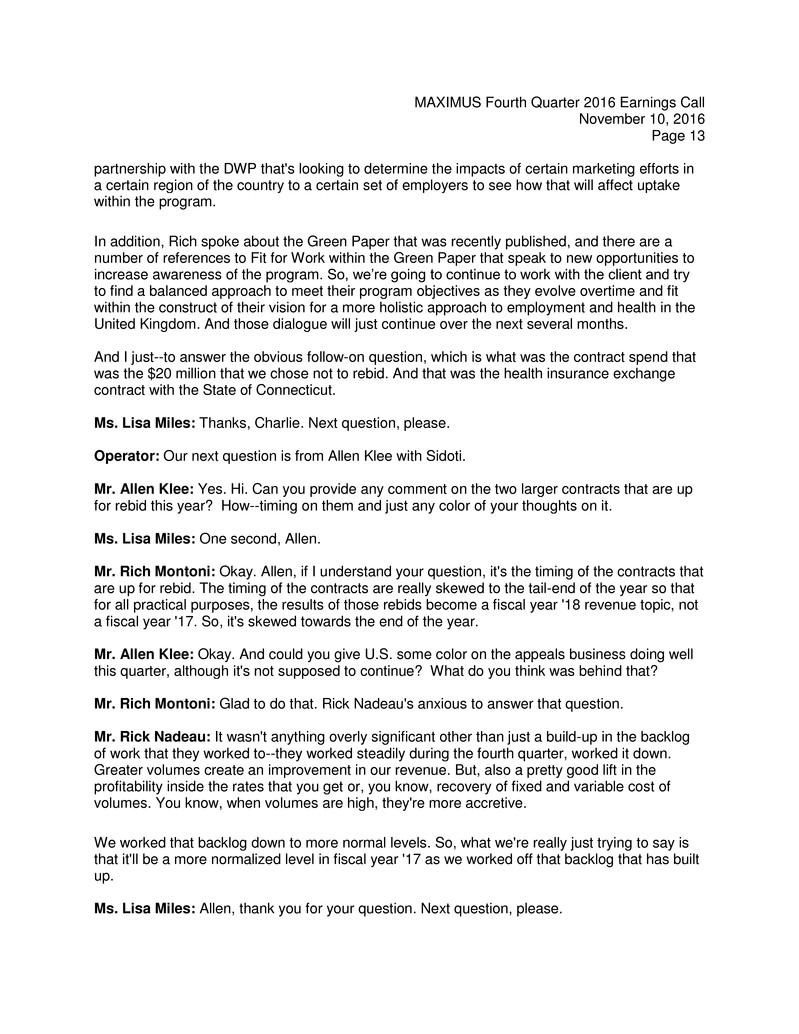
MAXIMUS Fourth Quarter 2016 Earnings Call
November 10, 2016
Page 13
partnership with the DWP that's looking to determine the impacts of certain marketing efforts in
a certain region of the country to a certain set of employers to see how that will affect uptake
within the program.
In addition, Rich spoke about the Green Paper that was recently published, and there are a
number of references to Fit for Work within the Green Paper that speak to new opportunities to
increase awareness of the program. So, we’re going to continue to work with the client and try
to find a balanced approach to meet their program objectives as they evolve overtime and fit
within the construct of their vision for a more holistic approach to employment and health in the
United Kingdom. And those dialogue will just continue over the next several months.
And I just--to answer the obvious follow-on question, which is what was the contract spend that
was the $20 million that we chose not to rebid. And that was the health insurance exchange
contract with the State of Connecticut.
Ms. Lisa Miles: Thanks, Charlie. Next question, please.
Operator: Our next question is from Allen Klee with Sidoti.
Mr. Allen Klee: Yes. Hi. Can you provide any comment on the two larger contracts that are up
for rebid this year? How--timing on them and just any color of your thoughts on it.
Ms. Lisa Miles: One second, Allen.
Mr. Rich Montoni: Okay. Allen, if I understand your question, it's the timing of the contracts that
are up for rebid. The timing of the contracts are really skewed to the tail-end of the year so that
for all practical purposes, the results of those rebids become a fiscal year '18 revenue topic, not
a fiscal year '17. So, it's skewed towards the end of the year.
Mr. Allen Klee: Okay. And could you give U.S. some color on the appeals business doing well
this quarter, although it's not supposed to continue? What do you think was behind that?
Mr. Rich Montoni: Glad to do that. Rick Nadeau's anxious to answer that question.
Mr. Rick Nadeau: It wasn't anything overly significant other than just a build-up in the backlog
of work that they worked to--they worked steadily during the fourth quarter, worked it down.
Greater volumes create an improvement in our revenue. But, also a pretty good lift in the
profitability inside the rates that you get or, you know, recovery of fixed and variable cost of
volumes. You know, when volumes are high, they're more accretive.
We worked that backlog down to more normal levels. So, what we're really just trying to say is
that it'll be a more normalized level in fiscal year '17 as we worked off that backlog that has built
up.
Ms. Lisa Miles: Allen, thank you for your question. Next question, please.
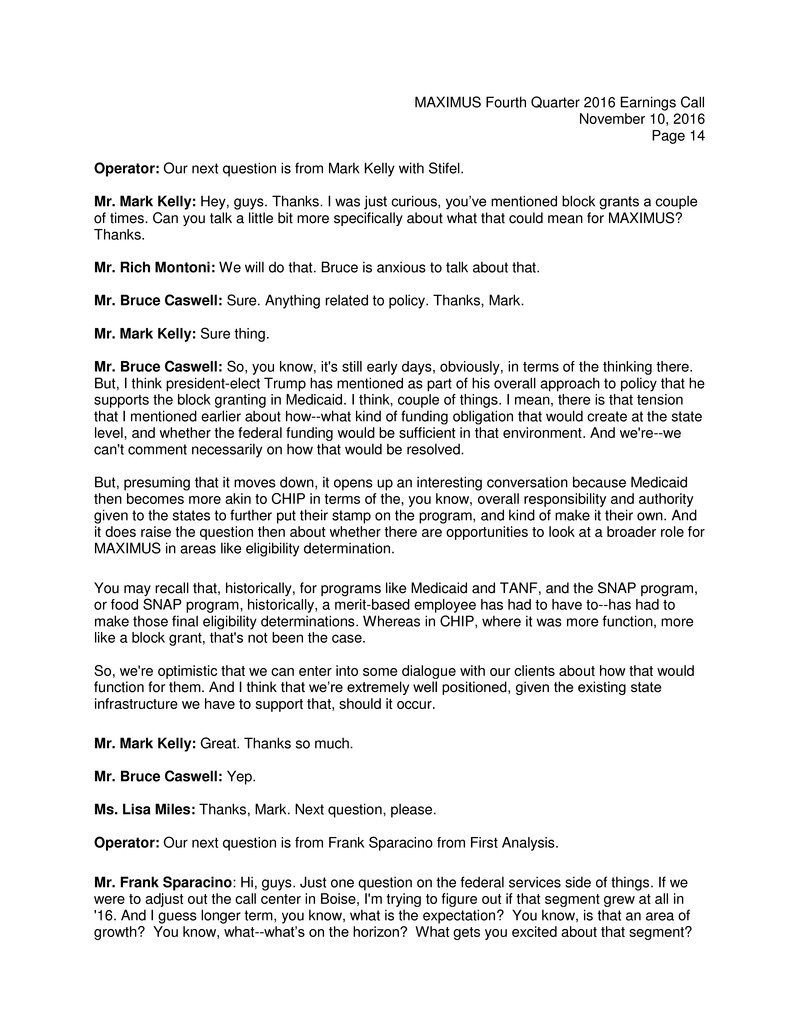
MAXIMUS Fourth Quarter 2016 Earnings Call
November 10, 2016
Page 14
Operator: Our next question is from Mark Kelly with Stifel.
Mr. Mark Kelly: Hey, guys. Thanks. I was just curious, you’ve mentioned block grants a couple
of times. Can you talk a little bit more specifically about what that could mean for MAXIMUS?
Thanks.
Mr. Rich Montoni: We will do that. Bruce is anxious to talk about that.
Mr. Bruce Caswell: Sure. Anything related to policy. Thanks, Mark.
Mr. Mark Kelly: Sure thing.
Mr. Bruce Caswell: So, you know, it's still early days, obviously, in terms of the thinking there.
But, I think president-elect Trump has mentioned as part of his overall approach to policy that he
supports the block granting in Medicaid. I think, couple of things. I mean, there is that tension
that I mentioned earlier about how--what kind of funding obligation that would create at the state
level, and whether the federal funding would be sufficient in that environment. And we're--we
can't comment necessarily on how that would be resolved.
But, presuming that it moves down, it opens up an interesting conversation because Medicaid
then becomes more akin to CHIP in terms of the, you know, overall responsibility and authority
given to the states to further put their stamp on the program, and kind of make it their own. And
it does raise the question then about whether there are opportunities to look at a broader role for
MAXIMUS in areas like eligibility determination.
You may recall that, historically, for programs like Medicaid and TANF, and the SNAP program,
or food SNAP program, historically, a merit-based employee has had to have to--has had to
make those final eligibility determinations. Whereas in CHIP, where it was more function, more
like a block grant, that's not been the case.
So, we're optimistic that we can enter into some dialogue with our clients about how that would
function for them. And I think that we’re extremely well positioned, given the existing state
infrastructure we have to support that, should it occur.
Mr. Mark Kelly: Great. Thanks so much.
Mr. Bruce Caswell: Yep.
Ms. Lisa Miles: Thanks, Mark. Next question, please.
Operator: Our next question is from Frank Sparacino from First Analysis.
Mr. Frank Sparacino: Hi, guys. Just one question on the federal services side of things. If we
were to adjust out the call center in Boise, I'm trying to figure out if that segment grew at all in
'16. And I guess longer term, you know, what is the expectation? You know, is that an area of
growth? You know, what--what’s on the horizon? What gets you excited about that segment?
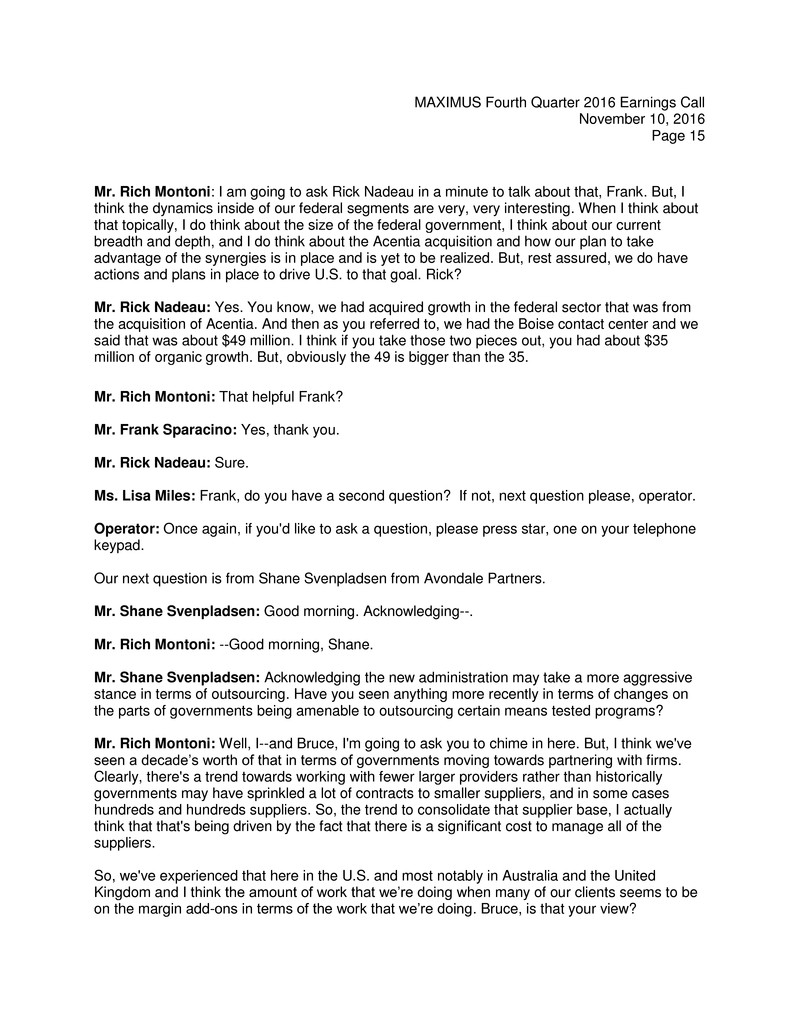
MAXIMUS Fourth Quarter 2016 Earnings Call
November 10, 2016
Page 15
Mr. Rich Montoni: I am going to ask Rick Nadeau in a minute to talk about that, Frank. But, I
think the dynamics inside of our federal segments are very, very interesting. When I think about
that topically, I do think about the size of the federal government, I think about our current
breadth and depth, and I do think about the Acentia acquisition and how our plan to take
advantage of the synergies is in place and is yet to be realized. But, rest assured, we do have
actions and plans in place to drive U.S. to that goal. Rick?
Mr. Rick Nadeau: Yes. You know, we had acquired growth in the federal sector that was from
the acquisition of Acentia. And then as you referred to, we had the Boise contact center and we
said that was about $49 million. I think if you take those two pieces out, you had about $35
million of organic growth. But, obviously the 49 is bigger than the 35.
Mr. Rich Montoni: That helpful Frank?
Mr. Frank Sparacino: Yes, thank you.
Mr. Rick Nadeau: Sure.
Ms. Lisa Miles: Frank, do you have a second question? If not, next question please, operator.
Operator: Once again, if you'd like to ask a question, please press star, one on your telephone
keypad.
Our next question is from Shane Svenpladsen from Avondale Partners.
Mr. Shane Svenpladsen: Good morning. Acknowledging--.
Mr. Rich Montoni: --Good morning, Shane.
Mr. Shane Svenpladsen: Acknowledging the new administration may take a more aggressive
stance in terms of outsourcing. Have you seen anything more recently in terms of changes on
the parts of governments being amenable to outsourcing certain means tested programs?
Mr. Rich Montoni: Well, I--and Bruce, I'm going to ask you to chime in here. But, I think we've
seen a decade’s worth of that in terms of governments moving towards partnering with firms.
Clearly, there's a trend towards working with fewer larger providers rather than historically
governments may have sprinkled a lot of contracts to smaller suppliers, and in some cases
hundreds and hundreds suppliers. So, the trend to consolidate that supplier base, I actually
think that that's being driven by the fact that there is a significant cost to manage all of the
suppliers.
So, we've experienced that here in the U.S. and most notably in Australia and the United
Kingdom and I think the amount of work that we’re doing when many of our clients seems to be
on the margin add-ons in terms of the work that we’re doing. Bruce, is that your view?

MAXIMUS Fourth Quarter 2016 Earnings Call
November 10, 2016
Page 16
Mr. Bruce Caswell: Absolutely my view. I think that, you know, really, Shane, when we look at
the model, if you're in the right place and you're able to have the dialogue with the client about
the problems they're facing at the moment, and thirdly you've got the infrastructure and ability to
deliver, you can really grow nicely off of existing contracts. And we’ve actually even kind of
modified our business delivery model to accommodate that through the use of greater shared
services centers where we can dynamically allocate, you know, demand to meet search
requirements for our clients. And there are several examples out there where I think we've seen
a propensity to outsource when clients have kind of an immediate need.
So, for example, one that was in the press where--is where we're helping the state of Arkansas
address a backlog in Medicaid renewal determinations of over 100,000 cases. And we were
able to rapidly respond to that, stand-up capability and help them through that issue.
So, I will say, I've been pleased with how the value proposition and the ability to provide that
kind of support, which itself can lead to longer term relationships, has been a bit on the uptick in
the marketplace.
Mr. Shane Svenpladsen: Appreciate that color. And then just quickly, if you could provide an
update on Acentia and kind of your progress in creating, you know, BPO opportunities within
those contract vehicles.
Mr. Bruce Caswell: I'll go ahead and take that, Shane. So, as you know, when we combined
with Acentia, we were able to add to our portfolio, if you will, about 12 new contract vehicles that
cover largely civilian and federal agencies in terms of our ability to then market to those
agencies and create new opportunities. So, we've always maintained that it would take some
time to gain traction in new opportunities resulting from that acquisition. And I will say that I've
been pleased with some of the initial pings that we've seen in terms of contract vehicles where
we've had bids that have expanded as a consequence of a larger capability that we can bring to
the table.
We've--you know, we--Rich mentioned in his prepared remarks that our business development
teams are fully integrated now, really pushing and pursuing new opportunities. Federal pipeline
itself remains quite strong. It does include new BBO business where we can leverage our core
capabilities, but go-to-market through those contract vehicles that I mentioned.
And also, if you recall, the federal government contracting space is one where there are larger
government-wide acquisition contracts that companies have to qualify for to then subsequently
receive task order opportunities.
And I will say, without, you know, disclosing the names of the vehicles themselves, we are, as a
consequence of the Acentia combination, in a position now to qualify for much larger
government-wide acquisition contracts that overtime will then deliver a lot of revenue through
task order. So, we expect to see--you know, it's worth mentioning as the new administration
comes on board and they put their appointees in place, and really begin to enact their agenda,
there may be a bit of a slowdown on the federal side.
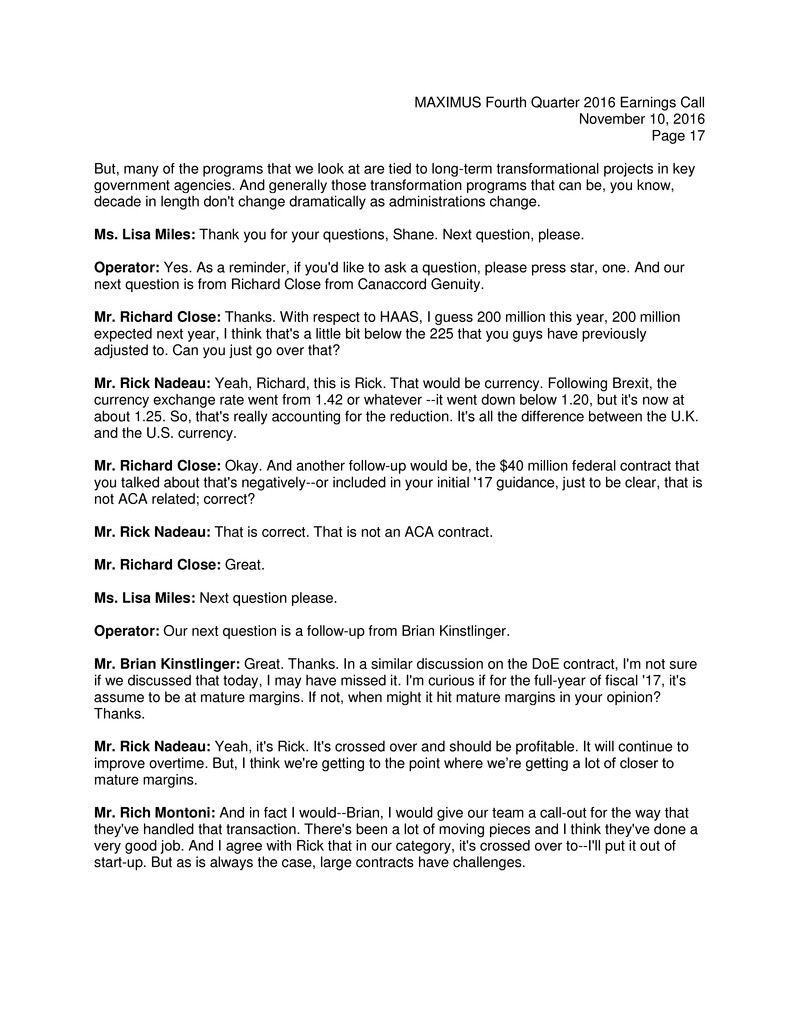
MAXIMUS Fourth Quarter 2016 Earnings Call
November 10, 2016
Page 17
But, many of the programs that we look at are tied to long-term transformational projects in key
government agencies. And generally those transformation programs that can be, you know,
decade in length don't change dramatically as administrations change.
Ms. Lisa Miles: Thank you for your questions, Shane. Next question, please.
Operator: Yes. As a reminder, if you'd like to ask a question, please press star, one. And our
next question is from Richard Close from Canaccord Genuity.
Mr. Richard Close: Thanks. With respect to HAAS, I guess 200 million this year, 200 million
expected next year, I think that's a little bit below the 225 that you guys have previously
adjusted to. Can you just go over that?
Mr. Rick Nadeau: Yeah, Richard, this is Rick. That would be currency. Following Brexit, the
currency exchange rate went from 1.42 or whatever --it went down below 1.20, but it's now at
about 1.25. So, that's really accounting for the reduction. It's all the difference between the U.K.
and the U.S. currency.
Mr. Richard Close: Okay. And another follow-up would be, the $40 million federal contract that
you talked about that's negatively--or included in your initial '17 guidance, just to be clear, that is
not ACA related; correct?
Mr. Rick Nadeau: That is correct. That is not an ACA contract.
Mr. Richard Close: Great.
Ms. Lisa Miles: Next question please.
Operator: Our next question is a follow-up from Brian Kinstlinger.
Mr. Brian Kinstlinger: Great. Thanks. In a similar discussion on the DoE contract, I'm not sure
if we discussed that today, I may have missed it. I'm curious if for the full-year of fiscal '17, it's
assume to be at mature margins. If not, when might it hit mature margins in your opinion?
Thanks.
Mr. Rick Nadeau: Yeah, it's Rick. It's crossed over and should be profitable. It will continue to
improve overtime. But, I think we're getting to the point where we’re getting a lot of closer to
mature margins.
Mr. Rich Montoni: And in fact I would--Brian, I would give our team a call-out for the way that
they've handled that transaction. There's been a lot of moving pieces and I think they've done a
very good job. And I agree with Rick that in our category, it's crossed over to--I'll put it out of
start-up. But as is always the case, large contracts have challenges.

MAXIMUS Fourth Quarter 2016 Earnings Call
November 10, 2016
Page 18
Mr. Brian Kinstlinger: So, just to be clear, in fiscal '18, there'll be a small slingshot effective in
the first half of the year it's not fully mature whereas it might be in the first half of fiscal '18. Is
that the way we should think about it?
Mr. Rick Nadeau: I would think that--the way I would put it is that all contracts that we have of
size, we should be improving the profitability of them overtime. But yes, we're still improving the
margin on that contract. But, I would be thinking smaller rather than bigger.
Mr. Rich Montoni: Yes, small slingshot, Brian.
Ms. Lisa Miles: Thanks, Brian. Next question, please.
Operator: Ladies and gentlemen, we have reached the end of the question and answer session
and are out of time for today’s call. MAXIMUS thanks you for your time and participation. You
may disconnect your lines at this time.
